








Bobby and Courtney Schlesinger’s life of luxe travel and family time in Westport.


Where to eat? A food writer shares which restaurants to try over the holidays.
 by elizabeth keyser
by elizabeth keyser

Meet the inspiring people who make life better for others in Fairfield County. Time to celebrate giving back.
by jill johnson mannA look at one of the biggest issues in the country: reproductive rights








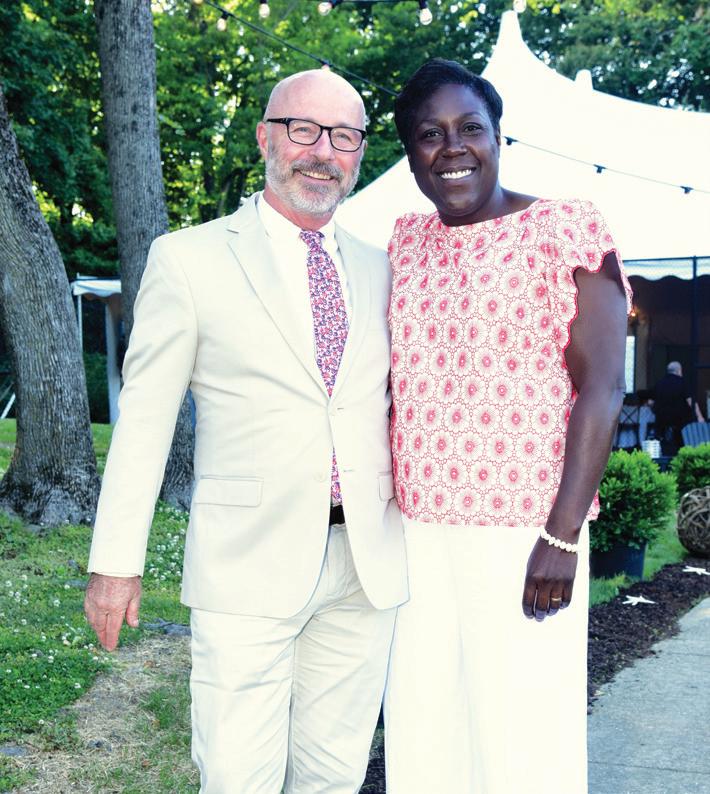










vol. 24 | no. 6 | november/december 2022


editorial editorial director

Cristin Marandino–cristin.marandino@moffly.com
editor: westport, fairfield living, stamford Diane Sembrot–diane.sembrot@moffly.com
style & community editor
Janel Alexander

books correspondent Emily Liebert

contributing editors
Megan Gagnon–editor, athome
Elizabeth Hole–editor, custom publishing
Julee Kaplan editor, new canaan • darien
Veronica Schoor—assistant editor, athome Amy Vischio–creative director-at-large, athome copy editors
Terry Christofferson, Lynne Piersall, David Podgurski, Scott Thomas


contributing writers
Liz Barron, Carol Leonetti Dannhauser, Timothy Dumas, Kim-Marie Galloway, Malia Frame, Elizabeth Keyser, Jill Johnson Mann






editorial advisory board G. Kenneth Bernhard, Bridgett Csapo-DiBonaventura, Nancy Conroy, Nancy Gault, Caren Hart Nelson, Jennifer O’Reilly






art senior art director



Venera Alexandrova venera.alexandrova@moffly.com senior art director Garvin Burke garvin.burke@moffly.com production director Tim Carr–tim.carr@moffly.com assistant art director
Lisa Marie Servidio–lisa.servidio@moffly.com senior photographer Bob Capazzo
digital media director of digital content strategy Diane Sembrot
digital marketing manager
Rachel MacDonald–rachel.macdonald@moffly.com
digital assistant Lloyd Gabi lloyd.gabi@moffly.com
Calendar@Moffly.com Editor@WestportMag.com Weddings@WestportMag.com
TO SUBSCRIBE, renew, or change your address, please email us at subscribe@westportmag.com, call 1-877-467-1735, or write to WESTPORT magazine, 111 Corporate Drive, Big Sandy, TX 75755 U.S. subscription rates: $19.95/1 year, $34.95/2 years; Canada and Foreign, U.S. $40/1 year; $69/2 years Prices are subject to change without notice
FOR QUALITY CUSTOM REPRINTS/E-PRINTS, please call 203-571-1645 or email reprints@moffly.com. All rights reserved. No part of this periodical may be reproduced without express permission of the publisher. ©2022 WESTPORT magazine is a registered trademark owned by Moffly Media. The opinions expressed by writers commissioned for articles published by WESTPORT are not necessarily those of the magazine.


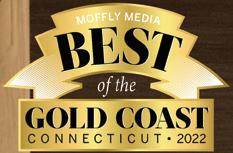
publisher Gabriella Mays westport•weston & wilton gabriella.mays@moffly.com
sales & marketing Andrew Amill publisher, greenwich andrew.amill@moffly.com
Gina Fusco publisher, new canaan•darien & rowayton gina.fusco@moffly.com

Karen Kelly-Micka publisher, stamford, ocean house karen.kelly@moffly.com
Robin O’Hara associate publisher, athome robin.ohara@moffly.com
Jonathan Moffly publisher, fairfield living publisher-at-large, greenwich jonathan@moffly.com
Hilary Hotchkiss account executive hilary.hotchkiss@moffly.com
Kathleen Dyke partnership and big picture manager kathleen.godbold@moffly.com
Rachel Shorten events director rachel.shorten@moffly.com
Lemuel Bandala sales assistant lemuel.bandala@moffly.com
Eillenn Bandala business assistant eillenn.bandala@moffly.com

business president Jonathan W. Moffly chief revenue officer Andrew Amill editorial director Cristin Marandino

director of digital content strategy Diane Sembrot business manager Elena Moffly elena@moffly.com cofounders
John W. Moffly IV & Donna C. Moffly donna@moffly.com
PUBLISHERS OF

FAIRFIELD LIVING NEW CANAAN • DARIEN
ROWAYTON WESTPORT STAMFORD and athome magazines 205 Main Street, Westport, CT 06880 phone: 203-222-0600 mail@moffly.com
ADVERTISING INQUIRIES: Lemuel Bandala 20 3-571-1610 or email advertise@moffly.com


We live in tumultuous times. A feeling of unabated change swirls around us with continuing Covid, inflation, a looming recession, the war in Ukraine and accelerating technologies we must adapt to every year. Toss in midterm elections shifting power between our two major parties, and we have unease.
Living in Russia, Japan, Australia, China, New Zealand and Thailand deepened my pride in our country—its resiliency and adaptability. I married a Russian whom I met while living in Tokyo on an exchange program from the University of Sydney. Our firstborn entered the world in Moscow. The political systems ranged across the spectrum from authoritarian with one-man or one-party rule to robustly democratic. Regardless of who governed, I learned that people are people. We value love and community. I made friends in all those countries.
Our responsibility as regional magazine media is to help the community thrive—to help people live better lives. At the top we celebrate what is good here—our neighbors, the culture, the history, things to do and places to go. And we tackle tough issues like domestic violence, bullying, addiction and women’s rights, in which we balance the hard realities with opportunities to make a difference. We highlight the people who truly want to make a positive difference in our lives, as in the Light a Fire awards for
volunteers extraordinaire and unsung heroes. Moffly Media supports over 150 nonprofits by sharing their message or helping them raise money to address important needs not supported by government services. As the media world evolves with ever more streaming services, social channels and websites, there is one thing we at Moffly want to do—help us understand each other and improve quality of life.
Enter politics in this crazy-feeling, divisive time and take a more middle road on the hot button issues between the extreme left and extreme right. I’m proud of how our editors handle different opinions. In the early 2000s for a congressional race, one of our magazines in its Editor’s Letter leaned a bit toward one candidate, another for the other candidate, and the third right down the middle. Connecticut is regarded overall as a moderately liberal state. Yet today’s politics are more polarizing than I can remember in my lifetime, with the seeming disappearance of a middle majority— the moderate voices that bring us together. Radical conservative voices, according to studies sited by Politico, out-shout liberal voices in social messaging that goes viral. Radical liberal voices, while less effective, tout extremes of position equally divisive. It all keeps us from coming together.
The top midterm races all feature our local natives. For Congress, Jayme Stevenson
(Darien) is facing off against Jim Himes (Greenwich). For the Senate, Leora Levy (Greenwich) is facing off with Dick Blumenthal (Greenwich). And for Governor, Bob Stefanowski (Madison) is facing off against Ned Lamont (Greenwich). All were successful prior to politics, and I respect all of them for their dedication. None I agree with entirely. For middle-of-the-roaders, it’s a tough place to be—whether politician or voter. So, this year, vote your conscience on who can bring people together for sensible moderation. But make sure to get out and vote to uphold freedom and safety, and to improve life for all who call this great country home.

Last year MRI Simmons conducted a thirdparty audience survey. You readers are ten times more engaged in making a difference in your community than the national average. Far beyond extraordinary, that’s unheard of for a region. You pack a punch—both locally and nationally. As your town magazine, we want to do best by you. We want to know your thoughts—your concerns, your passions, what’s important to you. We are here for you. Send us your ideas: editor@westportmag.com.
We are your town magazine.

Somehow, we’re at the end of 2022. How did that happen? I watched the weeks and months go by. I lived present and aware in each season. And I plan months ahead, as I prep materials for the magazine well in advance of publication. Yet, I am surprised that we are packing up a year of memories, closing the box and tucking it away in the closet. Where did the time go?


Let’s look back for a moment. We started our year with an interview with Dr. Scott Gottlieb, who helped us understand the state of Covid and prepare our thoughts for how to face another pandemic—when it comes.

In March, we met with Westport’s newly elected Selectwomen to see what they bring to the positions and what they’ll do for the town. We also welcomed Gabriele’s, and stopped by The Post for a little shopping. We then toured a home designed by interior designer Shelley Morris and her daughter, Victoria (the homeowner). Transplants from New York City, like many neighbors now, they settled into historic homes and made them fresh and cozy.
By May, writer Emily Liebert snagged an interview with the talented and evercharming Jane Green, a famous and multibest-selling author. My only regret with this story—wonderfully shot by photographer Jen Goldberg—is that I could not also hear Jane’s English accent. This issue also introduced The Mill, a big residential development of an abandoned factory—Westport moving forward.
High summer was all about your Best Of picks. This is the issue where you tell us your favorite restaurants, cafes, markets, fashion boutiques, salons, spas, fitness classes and so much more. We also introduced you to YOYA, a new shop in town.
Then, at the beginning of the school year, we introduced you to amazing local teens. Despite obstacles, they find a way to make the most of opportunities in academics, athletics, the arts and more to learn about who they are and what they might do one day. Most have just graduated high school and started freshman year in college; the future is bright before them. We also shared inspiration to stay fit, from tips for running a marathon to trying Pilates. Our big feature introduced you to the brilliant artist David Marchi, who came to his profession through a life-changing accident that lead to self-discovery, authenticity and acceptance.
The year is not done. We have the holiday season to celebrate family and friends and the good things about living here. I hope when you turn the pages, you find stories that introduce you to interesting people and new places to explore—and that you have that warm feeling that our towns are the only place you could truly call home for years to come.



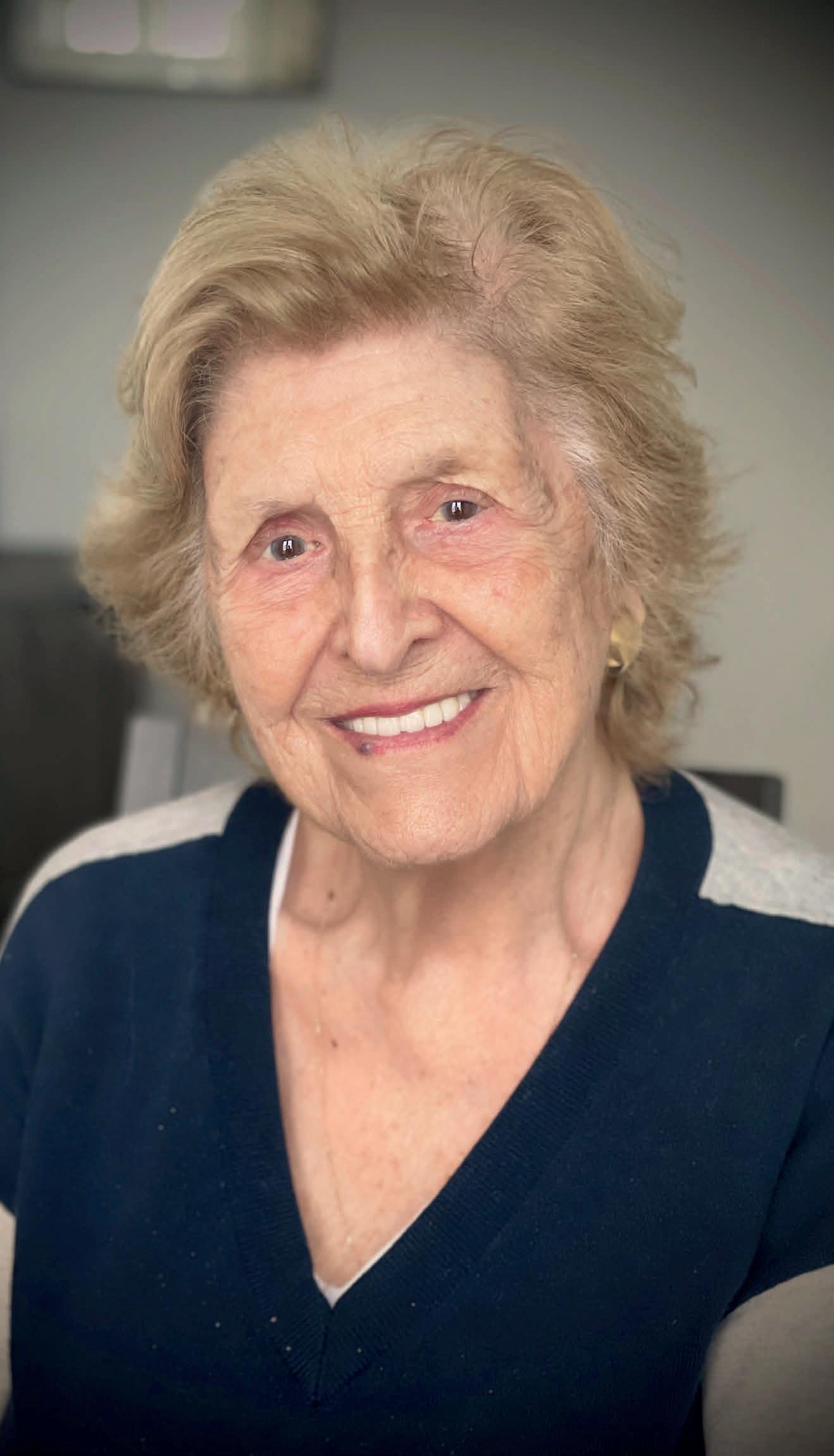
You know what’s fun? Parties. You know what’s not fun? Preparing for them—at least for those of us who never picked up the skills of hosting them, especially for kids. Where our creativity falters, Shannon Vindiola’s soars. She is the founder of Yozo Studio (yozostudio.com), a design and letterpress studio and party shop in Westport. She creates beautiful invitations and






other stationery—as well as adorable partiesin-a-box for kids that make party planning and party throwing easy. Vindiola says the parties are based on what kids have always loved: imagination, dress-up and hands-on play. Each kit activity is kid-tested by her daughters, who provide feedback with the honesty possible only from one’s own children. The kits—Firefighters to the Rescue, Groovy Flower Power, Mermaids & Pirates of the Sea,
Princesses & Knights Unite, Retro Bowling and Vintage Circus—have everything: invitations, thank-you notes, activities, sometimes dress up for kids (and sometimes also for adults), tabletop stuff (plates, napkins, cutlery, etc.), food suggestions, cake kit (candles, matches and serving set) and party favors with letterpress printed tags. It even has a planning book with deadlines and tips for games and activities.
Why did you get into this?
One day I asked, “Is this it?” (Hint: It wasn’t.) Sure, I worked in a creative environment at an ad agency, around really creative people, but I wasn’t doing anything creative. I did some cool strategy work. But most of my time was spent babysitting clients, eating lunch at my desk, doing a lot of status reports and organizing people. A lot of stuff I was really good at, but, ick. I wanted to be creative and make things. Not work 100 hours on soulless tasks.
So, I quit my job and went back to school. I loved art school. I mean really—what a dream. Taking design classes, color theory. Oh my gosh, it was so awesome. Like a cloud lifted and a whole new rainbow was in front of me—in colors I’d never seen before. I learned letterpress in a bookmaking class. The minute I cranked that press I knew I was going to start my own stationery company. I loved invitations and a great party. What’s more fun than having a party or going to one? That’s it. Make people’s life moments even better.
So, you started the party kits? Oh, our party line was no surprise. I started my family about the same time I started Yozo Studio, and, of course, I made paper, letterpress invitations for my girls’ parties. Actually, I created the entire party, soup to nuts. It was so much fun to create and to see the smiles on my kids’ faces! After countless, “This is the best party ever” from parents and kids, the parties became an official product.
I grew up in a family that entertained and was incredibly social. It began with my parents— my dad, a pilot in the Navy, and my mom as the officer’s wife. Gender roles of the 1950s aside, they could party—or at least that’s what I


heard my entire life. My dad retired from the Navy the year I was born, but their social life thrived well beyond their Navy years. I’m not talking the socialite type of social life, but the kind of authentic desire to be around people, share a meal, celebrate a milestone or just have a little fun together.
I vividly remember my parents and their closest friends hosting a brunch at our house before a football game. (I’m from Texas where football is everything!) It was Halloween day. There were no kids at the party, just me peeking through the door in my room. At the last minute, my mom made pumpkin costumes for the hosts. It wasn’t a costume party. Guests laughed at the fun surprise when they arrived. Also, my mom and I hand made the princess and knight outfits for my daughter’s fourth birthday party. That party was the first party and beginning of our Yozo party line.


Fun! 100 percent. It has to be fun for the kids or it simply won’t be a good party. Our party kits are different than others because they include activities to entertain the kids. We think this is critical to a successful party. What are you going to do with the kids when they arrive? How will they have fun? Not to worry. We’ve planned it and tested it to make sure kids enjoy the activities. We’ve hosted all of the themed parties multiple times, and we are confident they are fun.

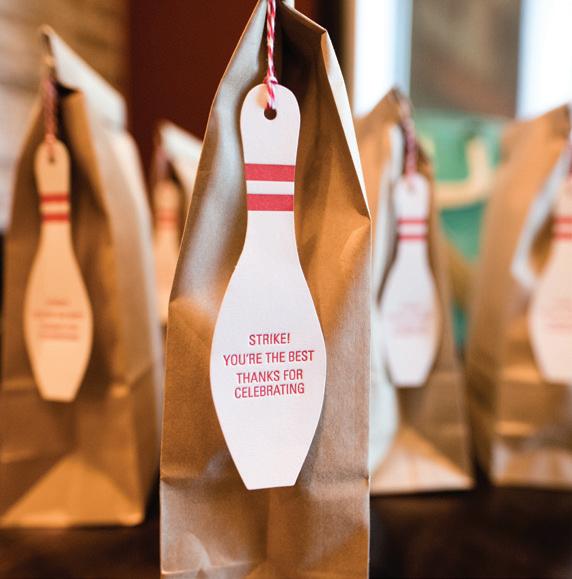

We are busy in November and December, finishing up custom holiday card orders. We also curate holiday gifts. It’s our answer to your annual question, “What am I going to give this year?” The gifts are thoughtful and custom.

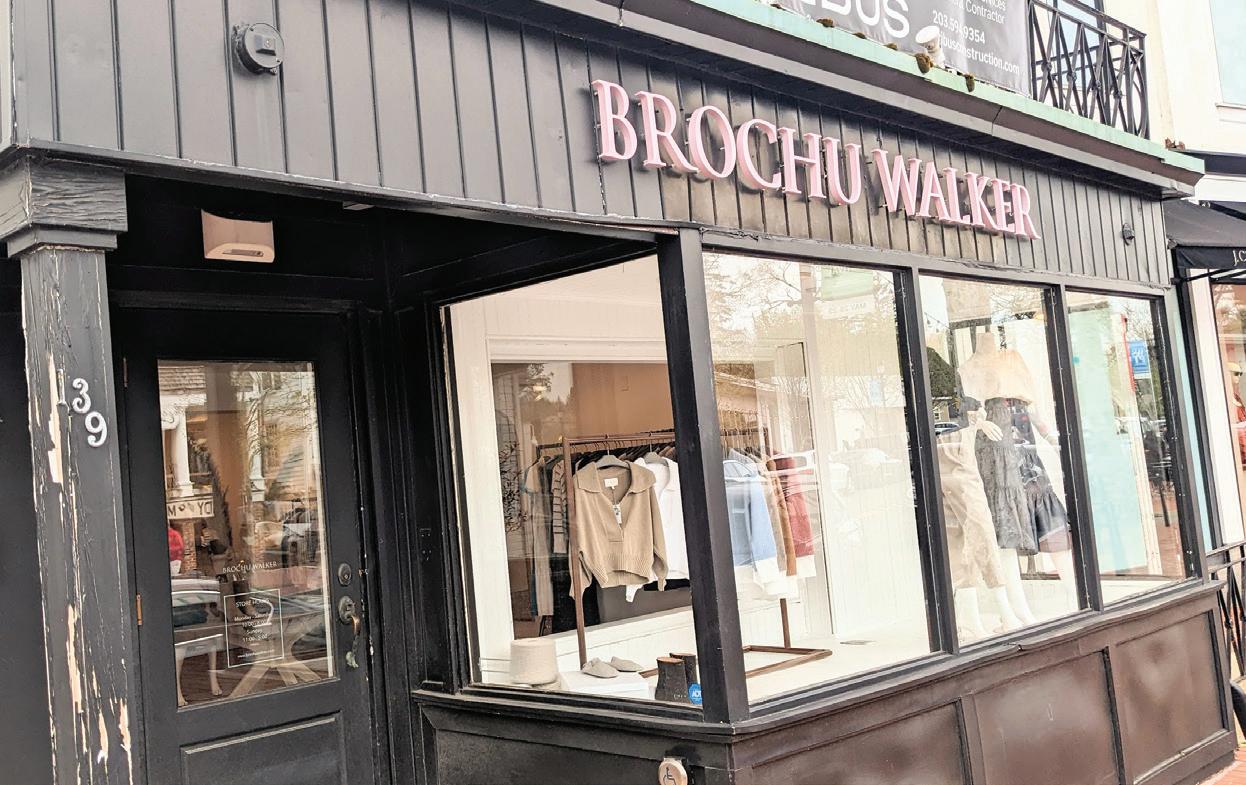
Many women dream of having a capsule wardrobe that is easy to navigate while still providing endless options. Brochu Walker joins Main Street in Westport and helps make that dream a reality. The Los Angeles–based brand provides “consciously designed” fashion that has an understated ease, making it a favorite of women around the globe.
The store, housed in one of the older Colonial-inspired buildings, reflects the brand’s signature: attention to detail, clean, luxurious and classic. Owner and Creative Leader Karine Dubner explains, “I have been wanting to open a store on the East Coast, and when I visited Connecticut last summer, I just fell in love with New England and especially Westport. The historical architecture, the water views, the magic of the everchanging seasons just spoke to me.” She achieved her vision well.

Brochu Walker aims to approach that “less is more” mind-set with a thoughtfully curated mix of knitwear and easy styles that serenely combine unfussy dressing with amazing quality. Its neutral palette makes it easy to layer its pieces and ground items in your wardrobe that might be screaming otherwise. Its popular “Looker” style is a seasonal favorite; it’s a sweater over an underlayer that gives the appearance of a styled look without any of the guesswork.

above: Cashmere abound in the store’s earthy setting right: Wall displays lined with the brand’s chic selections bottom, left: The store is located in the center of Main Street in Westport.

Breast cancer screening is in your hands. It’s easy to schedule your screening mammogram, no referral needed. We’re here for you every step of the way – from booking your appointment to getting your results back quickly.


 by diane sembrot
by diane sembrot
Looks like our reputation for working out is spreading. Westport welcomes Vuori (vuoriclothing.com) to 166 Main Street. The store opened at the beginning of September, as we were all renewing our commitment to not only sweaty training sessions, but also looking good. The brand, founded in SoCal, specializes in activewear for workouts, tennis matches and just running around town. The bright, beautiful store is full of energy, making it a fun place to shop (open seven days a week). Our pick? The Performance Jogger in Cosmo Heather ($94) and Energy Top in White ($54).







 DIRECTED + CHOREOGRAPHED BY JEFFREY L. PAGE
DIRECTED + CHOREOGRAPHED BY JEFFREY L. PAGE
The music of legendary jazz great Fats Waller will have us toe-tapping our way into another season. This exciting new vision by director-choreographer Jeffrey L. Page was a 2022 Critic’s Pick in The New York Times.
BY SOPHOCLESIt takes a strong woman to defy tyranny. And, what is ancient is new again, in this thrilling translation and adaptation by Kenneth Cavander that ties the past to our present.
What is it about a murder mystery? This classic thriller has been brilliantly adapted by playwright Jeffrey Hatcher, who has created even more surprises and diabolic twists than the celebrated Hitchcock film!
Get to know Paulina, the ‘Queen Bee’ of Aburi Girls’ Senior High School. This buoyant and biting comedy explores the universal similarities — and glaring differences — facing teenage girls across the globe.
We’re busy working out the details on the third show of our season. Stay tuned to find out what’s in store — whatever we decide on, we are sure you’ll love it!



London Super Long Cardigan, $728; Cashmere Imperfect Heart Mittens, $128; and Cashmere Love Beanie, $198; kerrirosenthal.com

Luxe Slipper Sock, $178. Westport; brochuwalker.com


Aspen Boucle Chair, $3,995, Westport; jennikayne.com
Arla Brushed Fairisle Pullover, $598, Westport; brochuwalker.com



The Julia Cableknit Sweater, $388; shopsisterkatie.com
Dawn Apricot fox jacket $4,000, Greenwich; pologeorgis.com


The Buttoned Up Puffer Luster Coat, $475, Greenwich/ Westport; shop. mitchellstores.com

Superstar Shearling Lined slip on sneaker, $680; modaoperandi.com
Turtleneck Belted Shell in Ecru, $425, and Ribbed Skirt in Ecru, $425, Greenwich/Westport; vince.com

MATEO Eve Baroque Pearl Earrings, $6,250, Mirta De Gisbert, Jewelry Consultant & Gemologist; mirtadegisbert.com




CADDIS Porgy Backstage Reading Glasses, $99,. Old Greenwich; athenabooksog.com

ANANYA Pearl Onyx Chakra Bracelet, Green Onyx, $3,920, Mirta De Gisbert, Jewelry Consultant & Gemologist; mirtadegisbert.com
One Stud Top Handle Bag, $3,650, Greenwich;
Open Multi-Diamond and Baroque White Pearl Ring, $3,290, Mirta De Gisbert, Jewelry Consultant & Gemologist; mirtadegisbert.com

TODD SNYDER
Canadian Cardigan Sweater, $698, Greenwich; toddsnyder.com

JENNI KAYNE


Mens Fisherman Sweater, $295, Greenwich; jennikayne.com
ELEVENTY
Leather Travel Bag, $1,795, Greenwich; eleventymilano.com 4
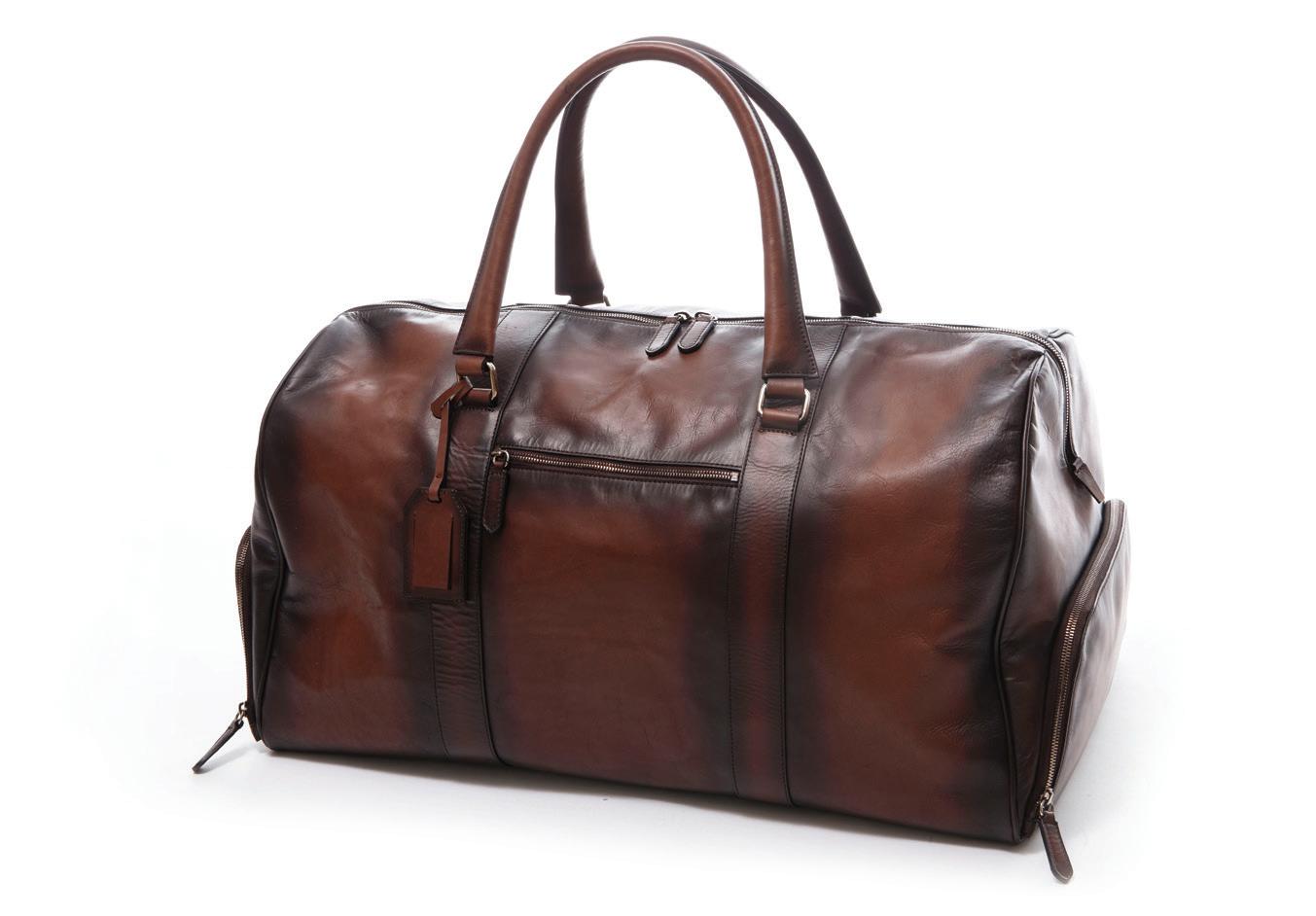
BRUNELLO CUCINELLI

Stripe Silk Necktie, $295, Westport, Greenwich; shop.mitchellstores.com


MANFREDI
Omega Speedmaster; $14,800, Greenwich, New Canaan; manfredijewels.com
TODD SNYDER + NEW ERA NY Yankees Low Profile Chalkstripe Cap, $120, Greenwich; toddsnyder.com

FRAME

Modern Flannel Long Sleeve zip Shirt, $398; frame-store.com
VINCE
Lorimer Suede Chukka Boot, $275, Greenwich, Westport; vince.com
Bartlet Forest Green and Creme Checkered Cap, $85; loefflerrandall.com


LOEFFLER RANDALL



Marcel Forest Green and Creme Checkered Mittens, $60; loefflerrandall.com




LOEFFLER RANDALL
Jimi Green Cashmere Baclava, $150; loefflerrandall.com

FRAME
Cropped Check Crew Off White Multi, $578; frame-store.com
LA LIGNE
Red Bonne Nuit Pajamas, $250, Greenwich; lalignenyc.com
The Catherine Staggered Diamond Locket, $5,170; monicarichkosann.com

18K Yellow Gold Pendant with 21 sprinkled diamonds, $4,075; hcreidjewelers.com

AKOYA CUFF
Flex Bangle, $9,800, Greenwich; betteridge.com 4


Yellow Gold Diamond Topaz and Mixed Gemstone Drop Earrings, $920, Westport; lbgreen.com


Half Mood Bracelet, $1,370, Greenwich, Westport; jlrocks.com 6

MATTIA CIELO
Diamond Twist Ring, $6,500, Westport, Greenwich; shopmitchellstores.com







IT’S TIME TO GET ALL LIT UP WITH THESE THIRTEEN SPARKLING TITLES. FROM A MISSING PERSONAL ASSISTANT AND A REALITY TV SHOW GONE WRONG TO A MYSTERIOUS DECK OF TAROT CARDS AND A RECIPE COLLECTION OF SOUTHERN-FARE-MEETS-FRENCH FLAIR, THERE’S SOMETHING HERE FOR EVERYONE ON YOUR HOLIDAY LIST. SO GIVE THE GIFT OF READING THIS SEASON …TO


Mara was surprised when reality TV producers visited Primal Instinct—the school where she teaches affluent clients to survive a night outdoors. She was even more shocked when they decided to cast her in their new show, Civilization, where contestants live off the land in an attempt to win a large sum of money. All she has to do is endure four strangers for six weeks…until things go terribly wrong, leaving them stranded in the
 BY MIA P. MANANSALA
BY MIA P. MANANSALA
Lila Macapagal’s cousin Ronnie is trouble. So when he returns to Shady Palms during Christmastime—after ghosting the family for fifteen years—she’s skeptical about his claim that recently purchasing a local winery means he’s back on his feet. Just when Lila’s new business is taking off and she’s found romance with her close friend Jae, Ronnie is suspected of murder and things start to get shady fast. Could her

A lot can transpire in forty-eight hours, especially when your world has been upended by your husband’s affair and an impending Category Four hurricane is about to hit Savannah, the city you call home—which is exactly what Ramona is facing. Not to mention her obnoxious boss, her nitpicking mother and her toilet-training toddler. Over the course of two days, as she attempts to evacuate, a neighborhood child and the class guinea pig are added to her motley crew. While Ramona steers her way through severe weather, police check points, bathroom crises, directives from her boss and sheepish texts from her philandering husband, she longs for the days when her life resembled a Prince song.
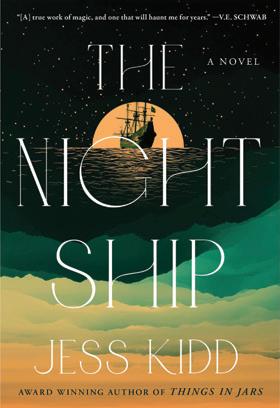
Inspired by a real-life event, this ambitious historical novel by the award-winning author of Things in Jars travels back to 1629 when Mayken, a recently orphaned young girl aboard Batavia, one of the greatest ships of the Dutch Golden Age, is shipwrecked on an island off Western Australia on her way to the Netherlands East Indies. Three hundred years later—in 1989—a lonely boy named Gil finds a home with his grandfather on the same island, where his late mother once lived, and unearths Mayken’s story. Weaving a captivating tale of friendship, loss, cruelty, and absolution, Kidd does not disappoint.
One momentous summer. Two teenage rebels. And the art that indelibly alters their lives. These are the ingredients that comprise this boisterous novel by the New York Times bestselling author of Nothing to See Here. When sixteenyear-old aspiring writer and loner Frankie Budge meets Zeke, a gifted artist who’s just moved into his grandmother’s unhappy home in Coalfield, Tennessee, romance and creativity abound. The enigmatic and anonymous posters they craft together immediately become memorable and people begin to wonder whom to attribute them to—a mystery that breeds perilous consequences and jeopardizes their close connection. Two decades later, Frances Eleanor Budge—a distinguished author, mom and wife—is informed that journalist Mazzy Brower is penning a story about the Coalfield Panic of 1996 and she realizes that the secrets she’s kept hidden will either come back to haunt her or set her free.
YOUR LOVED ONES AND YOURSELF. by emily liebert
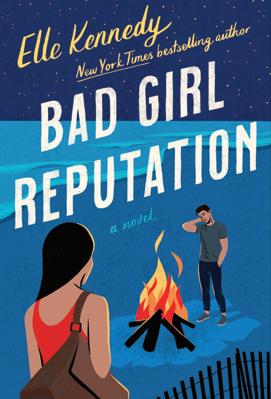 BY ELLE KENNEDY
BY ELLE KENNEDY
When one-time bad girl Genevieve West revisits her small coastal hometown for her mother’s funeral, her goal is to avoid her sexy ex-boyfriend Evan Hartley. She’s not interested in resuming their once tempestuous relationship and vows not to make any more imprudent decisions. Instead, she plans to temporarily help run her father’s business until he can find a replacement. Unbeknownst to Genevieve, Evan intends to win her back. That is, if second chances are really possible. And if a bad reputation can become a thing of the past.
 BY ELIZABETH MCCRACKEN
BY ELIZABETH MCCRACKEN
Nearly a year after her largerthan-life mother passed away, the book’s narrator travels to London, her mom’s favorite city, to reflect on her life and their relationship. The woman, who’s a writer, muses about her mother’s unrivaled determination, her will to carry on despite physical challenges, her munificence and her vivid sense of humor. In doing so, she begins to wonder if chronicling this grandeur will be an act of love or infidelity. Through McCracken’s intense analysis of both grief and rejuvenation, the tenderness of the child-parent bond is revealed and we’re reminded that the beauty in art and writing is continuous.
 BY SUZANNE PARK
BY SUZANNE PARK
If you’re searching for a sidesplitting rom-com, look no further than Park’s new YA novel about two rivals who join forces to save their families’ livelihoods and Christmas, too! Chloe Kwon and Peter Li do not get along. Their parents operate competing restaurants in the Riverwood Mall food court and they try to avoid each other at all costs. But when the mall is about to be purchased and demolished by an incoming developer and eviction notices are being dispersed right before the holidays, Chloe and Peter have to set aside their dislike for one another and work as a team. In doing so, they discover that the Kwon and Li vendetta is much graver than either of them had ever known.
In this stirring debut, Ann Stilwell is looking forward to her summer working as a curatorial associate at the Metropolitan Museum of Art, but instead she’s assigned to The Cloisters—a gothic museum and garden devoted to medieval art and the tradition of divination. As a means of avoiding her painful past, Ann involves herself with a group of researches and their peculiar notions about the history of fortune telling. But what begins as scholarly inquisitiveness rapidly turns into a profound fixation when Ann uncovers a cryptic fifteenthcentury deck of tarot cards that might determine the future. Soon enough, she finds herself engaged in a precarious game of authority and seduction that becomes deadly and her desperate pursuit for answers will keep you in suspense.
THE PRISONER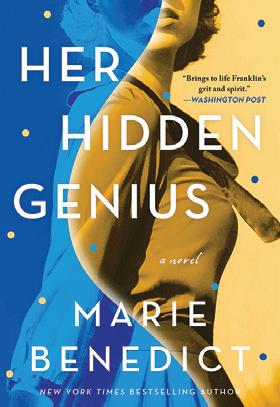
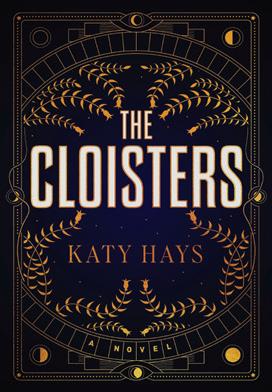
 BY B.A. PARIS
BY B.A. PARIS
From The New York Times
bestselling author of Behind Closed Doors, comes this heart-pounding novel about a woman who marries into a family with deadly objectives. When Amelie awakes in a pitchblack room, unaware of her surroundings and how she ended up there, she’s forced to ask herself if being imprisoned is safer than the glamorous life she’d become accustomed to. And she may not like the answer.

 BY KIMBERLY BELLE
BY KIMBERLY BELLE
This entrancing thriller exposes the dark underbelly of the digital universe when a mommy blogger’s assistant disappears. Alex never imagined that her penchant for sharing family photos and motivational messages online would transform from a hobby into a full-time career as an influencer. Or that one contentious post could turn toxic. To make matters much worse, when she contacts her trusty assistant A.C. to help remedy the situation, she’s met with radio silence, a police investigation, and a woman found murdered.
Brimming with over 100 recipes inspired by “traditional Southern fare and French culinary flair,” along with cooking, serving and entertaining secrets, this exquisite anthology is perfect for the gourmand in your life. Hitz, a recognized chef and expert host, believes that every day should be a culinary celebration and he expresses this through the style and sophistication of his mouthwatering food—from mini crab cakes with mango chutney and mustard-crusted rack of lamb to lemon pecan shortbread cookies. Bon appétit!
Rosalind Franklin has always been eccentric and a bit of a genius. She adores working in the field of science and using the static laws of physics and chemistry to lead her experiments. And she truly believes she can reveal enigmas behind the double helix structure of DNA, which means she’ll never have to listen to her colleagues gripe about her again. Regrettably, once she’s achieved her lofty goal, three men take credit for her brilliant discovery—one that advanced the world’s perception of humankind.
HER HIDDEN GENIUS BY MARIE BENEDICT




The time between Thanksgiving and the New Year brings a lot of activity—we’re out shopping for gifts; we’re cooking our favorite recipes for big get-togethers; we’re decorating our homes; we’re just doing more (joyfully, but, yes, lots more). As we move into this season, we need a place that is peaceful. Whether it’s tucking our toes under a soft throw blanket or inhaling the scent of pine from a freshly lit candle, this season gives us a chance to indulge in the softer side of life. To make it easier to feather our nest, we asked a few local pros for their top-of-mind ideas to try.

W hen your idea of cozy is neutral colors, natural wood and rounded edges, you’ll find a home away from home at Westport’s ELEISH VAN BREEMS (evbantiques.com). The Scandinavian store has a nervesoothing environment as you check out its collection of dishes, blankets and other furnishings with Nordic style. Its showrooms have furniture, carpets, lighting, wall art and more to shop when you want a statement piece, like a reading chair or minimalist contemporary lamp. Most are set up in vignettes, so you don’t have to imagine what a cohesive collection would look like and even feel like—that softness of texture, shape and color.

Aside from the natural knits and fabrics and the leather, there is also the gentle light. Take, for example, the Swedish Brass leaf candleholder with natural or black base. It is made using an ancient Japanese technique called shou sugi ban. The wood base is charred, both preserving it and making it fire resistant. The candleholder— with the brass leaf of an oak tree, chestnut tree or avocado tree— adds just the right amount of glow to a window, as a trio along a mantel or atop a couple of favorite tables. It’s a minimalistapproved way to add candlelight and shimmer, as well as interesting handmade texture, to a serene scene at home.

“For the fall, bringing reflective light into interiors helps create warm, comforting spaces. Layering textures and introducing luxurious fabrics, such as cashmere and alpaca, into unexpected applications help create cozy spaces that are warm and inviting.”
—RHONDA ELEISH, co-owner of Eleish Van Breems
A ptly named for its location along The Post Road in Westport, THE POST (thepostct .com) is stocked from end to end with home accessories. Around the holidays, it’s a wonderland of gift ideas as well as finds for creating a cheerful home. This isn’t the place for chic and minimal; rather, it’s for layers and extras and surprising delights. Think of it as a shop to help you tell a warm and wonderful story in your home—sparkle here, softness there. Shoppers can find fresh and modern items that have a nostalgic touch and are carefully chosen for the local taste.
Owner Deb Placey shares two picks that make a home warm and cozy. First, the New Zealand mohair blanket from Lands Downunder. “There’s nothing better than cozying up with family and friends in front of a crackling fire and with a glass of wine,” she says. “We have the softest Mohair blankets—and they’re so chic—to watch your Netflix show or cheer on your favorite football team on Sundays.”


Her second pick, the Frasier Fir scented candle from Thymes, has long been part of her own seasonal tradition. “Nothing says holiday
left: A favorite go-to for the holidays—a Frasier Fir candle by Thymes below: New Zealand mohair blankets from Lands Downunder
like the scent of fresh pine,” she says. “Frasier Fir makes the house smell like you’ve just cut down the tree. When you get home and want to feel the holiday spirit, Frasier Fir is everyone’s favorite. It literally lights up the home!”

Deb also shares advise on how to keep your space peaceful and uncluttered as well as traditional, yet also fresh. “Don’t be afraid to change your look at holiday time,” she says. “Bringing out family heirlooms and ornaments with sentimental value is so important, but you can add to your collection with what feels right for the season. Every year my daughters choose a color, whether it’s silver or gold or a light blue, and we try to incorporate it in our tree trimmings and gift wraps. It gives them something to look forward to and makes the season special.”
In short, when creating a welcoming environment at home, consider look, touch and aroma, and what feels special to you—and layer it joyfully.
“We have the softest mohair blankets, and they're so chic!”
–DEB PLACEY, owner of The Post
I f you’re looking for home accessories, why not shop in a home?

Head to SERENA & LILY (serenaandlily.com), which is located in a transformed historic house in downtown Westport. Every room has treasures that you’ll want to bring home. The blankets, frames, lighting, candle holders, throw pillows and more all share a quality of being part of a personal collection—coastal, elevated and tasteful. With the currents of natural white, foggysea blue and sunset-warm corals, everything in the store works together harmoniously. In short, you can’t help but find things that complement one another.
Caitlin O’Keeffe, merchandise field manager at Serena & Lily, shares a few tips on how to add warmth and coziness with that beachy vibe around the holidays. “Create a warm and inviting home

during the holidays by draping ultra-soft alpaca or merino wool throws on the couch for bundling up on cozy nights by the fireplace,” she begins, “while an adjacent reading nook makes for the perfect space to unwind. Put on a set of soft brushed cotton pajamas to complete the evening.”
Because there is no “off season” to living near the water, changing a beachy feel in winter is about layering warmth in various ways. “Placing votives and candles in varying heights on the dining table or the mantle adds dimensions and illuminates different areas of the space, bringing a soft, warm glow to the room,” O’Keeffe continues. “Incorporate touches of coastal elegance for a relaxed feel at home with luxurious raw silk pillows, a fresh magnolia wreath and a rattan bar cart filled with holiday drink favorites.”
 left and above: Just like your favorite rib-knit sweater, Serena & Lily's Ashland Alpaca Throw blankets in soft premium alpaca wool will last for years. The heathered yarns in soft neutral colors add to their appeal.
above: Holiday crackers, here seen in Serena & Lily's gilded-leaf motif, adds a touch of fun to a meal around the holidays.
left and above: Just like your favorite rib-knit sweater, Serena & Lily's Ashland Alpaca Throw blankets in soft premium alpaca wool will last for years. The heathered yarns in soft neutral colors add to their appeal.
above: Holiday crackers, here seen in Serena & Lily's gilded-leaf motif, adds a touch of fun to a meal around the holidays.
“Create a warm and inviting home during the holidays by draping ultra-soft alpaca or merino wool throws on the couch for bundling up on cozy nights by the fireplace.”–CAITLIN
O’KEEFFE, merchandise field manager at Serena & Lily PHOTOGRAPHS:
I f you like a clean-slate look, you don’t have to sacrifice softness. Minimalism doesn’t have to be all concrete and steel. For an elevated feel, head to STOWED (stowedhome.com). The shop shows you how to make less look like so much more: more comfort, more tranquility, more style.


“We like to refresh our space seasonally, at the very least. So, when thinking about the holidays, we are still about less is more. Instead of opting for clutter galore, we gravitate toward keeping it simple with cozy textures and a tonal color palette of warm whites. Picture our mohair or merino wool rugs under your feet—outlining a room dressed with our mohair throw pillows tossed on sofas or accent chairs,” says Elissia Sigalow, founder of the shop. “Add some tall, white, thin candles and cinnamon or pumpkin aromas, and your space will feel 'holiday.'
To top it off, we always suggest life in any room. Try some large branches—pussy willows are a good option—or if you are
craving color, throw in some deep maroon or burgundy flowers, like anemones.”

Elissia, who left her Wall Street career as a lawyer to start the company, is a master of clean lines with a hint of Nordic accent. STOWED offers handmade furniture and complementing home extras.
“Our bent-wood collection is ideal for hosting gatherings in your home,” she says. “Pull up a STOWED desk chair or bench to your dining collection, and, just like that, you have full-seating growth in that cool farmhouse design—a room styled and ready for conversation. Add some of our sheepskin hides over the back of any chair, and you’ll really feel that winter warmth. Include some of our velvets in your collection of slipcovers, or simply change the color, and you have a brand-new look. Just like that. Now, time to host.”
The look is proof that, when done right, less can be more—and very plush.
all the seasons, the holidays are when we all typically embrace our homes. We host, gather, make memories and take overall stock in our surroundings. If you’re anything like us, your surroundings affect your emotions. Once you get to know us, you’ll know that we go for a balanced mix of elegant and casual.”
“Of–ELISSIA SIGALOW, founder of STOWED































W hat if you are fresh out of the city and feeling lost in the suburbs? That’s when you need a shot of urban, high-end, modern, super-stylish and unique furniture, media systems, lighting, rugs, accessories, art and more from WEST | OUT EAST (westouteast .com). Though the store in Westport is small, it is clearly packed with informed design finds. The collection is curated by the design team at West Chin Architects & Interior Designers.
Refreshing a look—and making a space comforting and uplifting during the holidays—doesn’t have to be complicated. “Lighten up the space by adding table and floor lamps that are sculptural and add warmth to the space,” says Kimberly Warren, showroom director in Westport. “Bring some of the outdoors in by getting new

planters and vases to add a pop of natural color.”



November begins the cold season, yet we’re entertaining at home more often. We need to warm it up. “Spice up the serve ware, vases and candle holders to create a warm and inviting tablescape,” Kimberly advises. “Add bright cozy colors to your living room with new throw blankets and pillows.”
Of course, you can’t go wrong with the right seating, which works not only for putting guests at ease, but also gives you a chance to sink into softness once the party is over and the house is all yours again. “The Extrasoft sofa,” Kimberly says of her pick, “is a great piece for entertaining being able to face multiple directions, but it is also great for cozying up for a movie or watching a football game.”
above: Bring in a bit of nature—and consider a West | Out East's vase or planter. below: The Extrasoft Modular Sofa can be arranged just how you want it. above: The 28T Series brass orb, which has a dimming lighting system, can be placed on a table or hung on a wall. below: Servingwear that is anything but boring.“Lighten up the space by adding table and floor lamps that are sculptural and add warmth to the space.”
inWestport PHOTOGRAPHS: SOFA BY TOMMASO SARTORI; OTHERS, CONTRIBUTED














Sconset Square, not unlike other parts of Westport, is being redesigned. One of the newest stores to open is Jenni Kayne (jennikayne.com).
The California-based lifestyle brand opened its fourth dedicated home store at the end of summer. It is nestled in neatly with other elevated home-design stores of the shopping square. Its look is hand-crafted furniture and laid-back accessories; it takes the edge off of life. The 1,954-square-foot showroom is spa-like, with a gentle mix of neutrals, including shades of white and earthy tones. Everything goes with everything else, so it’s complete harmony, from the bed, side
table and coffee table to the candles, blankets and dishes.
Stressed out? Head to the spa, or just shop this new store. The brand even has a skincare line, Oak Essentials, which was launched in 2021. All products are non-GMO, cruelty-free and organic whenever possible. The latest, Oak Essentials first-ever AM Vitamin C Serum and PM Retinol Serum, came to market in October. These new choices are multitaskers with such benefits as regeneration of collagen and perfecting skin tone, pigmentation and texture. Even more, they were created to work with all skin types.


Life is beautiful in this new Westport shop.









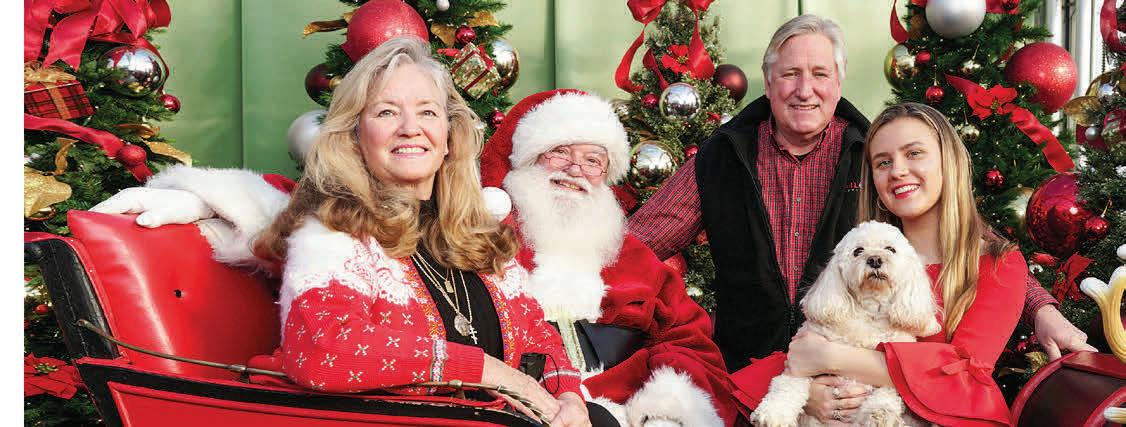





























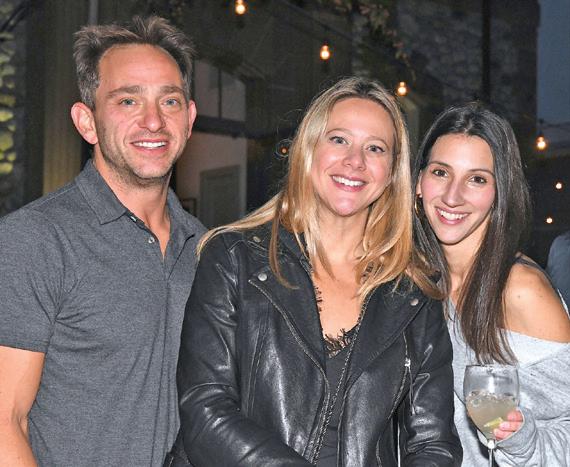

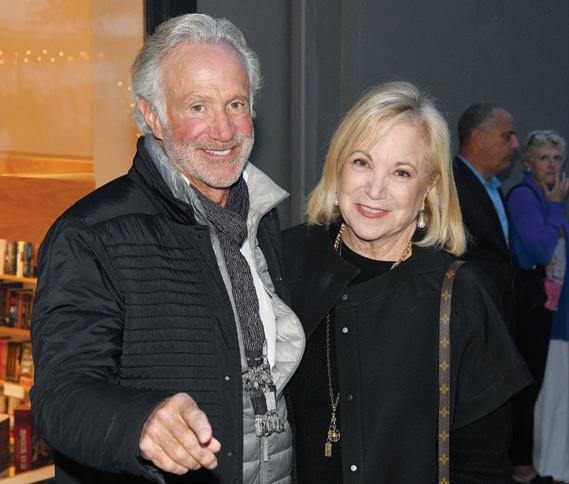
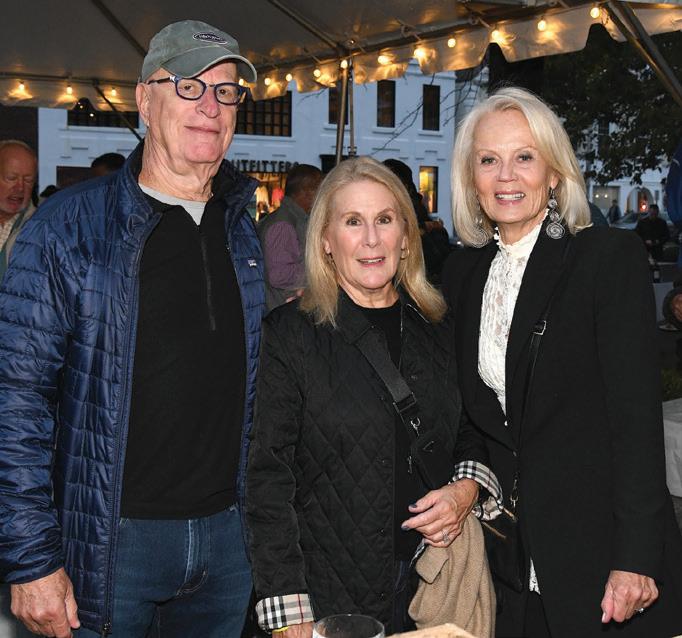

yndi Lauper did not just take the stage in Westport, she owned it. The singer, songwriter and actress, who is known worldwide for her Grammy Awards and pop hits such as “Girls Just Want to Have Fun,” “True Colors,” and “Time After Time,” lit up the Levitt Pavilion’s Epstein Stage for its annual gala. The evening was the pinnacle of the 2022 season, which featured several Stars-on-Tour events alongside sixty-six shows presented free of charge. Lead Sponsorship for the Gala was provided by The Claudia & Arthur Cohen Foundation, and the pre-concert gala cocktail party—held at Don Memo and Walrus Alley— was sponsored by Roz and Bud Siegel. The sold-out event welcomed 1,800 attendees, all of whom just wanna have, and definitely had, fun. The event is a major fundraiser for the arts nonprofit, which was established in 1973 and provides free shows; it relies on support from businesses, foundations and other donors. See more at levittpavilion.com. W



She’s a little bit Texas. He’s a lot Palm Beach.
Yet Westport couple bobby and courtney schlesinger still make sweet music together—as lead singers of their rock band, Pool House (named for their home-based practice venue). While belting out lyrics is more of an indulgent hobby than a full-time job, they’ve found the perfect balance between playing and working hard. I sat down with this multitalented duo to find out more about their lives, their careers and what makes them tick. by emily liebert // portrait by bailey ann photography
 The Schlesingers with their children, Jack and Lily, at their Westport home
The Schlesingers with their children, Jack and Lily, at their Westport home
Bobby: My grandfather started in the real estate business in the early 1960s. Soon thereafter my father joined him, and today, my two brothers and I run the business. The Brazilian Court, which we acquired in 2001, represented our first venture into hospitality and our first acquisition in Palm Beach; so I wouldn’t say that I grew up in the hotel business. The focus growing up was on multifamily real estate. I spent my summers renting apartments, doing lease audits and absorbing that side of the business. The hotel side was something that none of us had any real experience in; I sort of jumped in head first and had to learn on the fly. Our portfolio of hotels expanded quickly to seven properties from the Florida Keys, to Miami Beach, to Palm Beach, all the way to Atlanta, so it was a true trial-by-fire education in running these incredibly complex assets.
Did you always know you would go into the family biz?
Bobby: I think a part of me always knew and a part of me resisted. There can be a stigma of nepotism surrounding family businesses, especially with each subsequent generation, but I couldn’t be prouder that my brothers and I are keeping our grandfather’s and father’s legacies alive and further expanding on something that, one day, if they so choose, our kids will have the opportunity to perpetuate. Also, you’ll never work harder than for your family, so I’m lucky to have a real purpose every day. Today, I lead all acquisitions and dispositions and capital markets financing for the company as well as operations for our internal hospitality management company.
Bobby: Today we own over thirty apartment complexes in New York, Connecticut and Florida, totaling about 3,500 units. We also own four hotels: three in Palm Beach (The Brazilian Court, The Ambassador and The Palm Beach Resort) and one in the Florida Keys (Little Torch Cottages). We are also actively in construction on projects in Brooklyn, Stamford and Great Neck.
The Brazilian Court is one of my favorite hotels. In your mind, what is it that makes it so special?
Bobby: The hotel benefits from an irreplaceable location nestled amongst single-family homes in Palm Beach, an incredible amount of private outdoor space within the two courtyards, for which the hotel was named, a storied history of operating since 1926, food and beverage by Chef Daniel Boulud and the largest hotel rooms on the island. But I think personal involvement is
—BOBBY SCHLESINGERwhat makes it truly special. The term “boutique hotel” has lost a lot of its meaning in the past decade. Marriott today has a boutique division, which almost seems oxymoronic in nature. Even hotels that are owned by private individuals, but managed by institutional companies, tend to forget what makes a boutique property so desirable. Most of my favorite hotels to stay at are small properties that are run by a family or a proprietor who is intimately involved, and that is how we approach The Brazilian Court. Every decision, from the room design, to the staffing, to menu development, to on-property programming is based on a very specific vision that we’ve developed. It’s what makes us so proud to share that vision with our valued customers every day and create a truly unique guest experience.
kids, Jack and Lily?
Courtney: Because our kids are only three and one, we’ve been fortunate enough to spend winters in Palm Beach for the past several years. When we’re not based out of there, Bobby flies down for business regularly. Palm Beach can seem intimidating from a distance, but it’s truly one of the most beautiful and relaxing places on Earth—you just have to know where to look. Some of our favorite things to do when we’re there are going to get fresh juices from Don Victorio’s and watching our three-year-old, Jack, devour the acai bowls from Celis Produce. We also love morning swims together in the ocean when the water is like glass, walking to the Lake Worth Farmers market for some of the best grapefruit juice you’ll ever taste, dinners on the patio at Café Boulud, posting up at the bar at Le Bilboquet for a late-night drink and grabbing some famous key lime pie at the Old Key Lime House. A great daytime activity with the kids is a trip to the Tradewinds & Atlantic Railroad and a stop by Willy Café for some delicious healthy food after. We also have fun taking our kids to the Rec Center Playground and story time at The Society of the Four Arts. Our kids are in heaven when they’re there. Jack will spend the morning on the beach creating elaborate sand construction projects with Bobby, but his favorite thing is to visit the Fire Station and Sloan’s for ice cream.
When did you know you wanted to become a comedian and why? Did you grow up in a household full of humor and laughter?
Courtney: I’ve always loved making people smile, and when I was younger, I thought the way to do that was by becoming a clown. My parents suggested I try acting instead, and—later in life—when I enrolled in my first acting class in Los Angeles, my teacher said my dramatic monologue sounded much more like a stand-up skit and sent me straight to The Improv, where I began comedy lessons.
Your family owns hotels and real estate in Palm Beach. Was this a big part of your life growing up?
Which hotels and properties does your family currently own?
How much time do you spend in Palm
and what are your favorite things to do there with your
Most of my favorite hotels to stay at are small properties that are run by a family or a proprietor who is intimately involved, and that is how we approach The Brazilian Court.
above: Courtney on the patio of a rooftop terrace suite at The Brazilian Court Hotel



• A room with handpainted wall coverings by Austin Kerr below: The south courtyard • The family with son, Jack, in Palm Beach

above: Courtney and a friend relax at the pool at The Brazilian Court • The Bar at Café Boulud below: A serene patio suite room at The Brazilian Court



Tell us about your comedy material and how you come up with it. Do you feel pressure to always be funny?
Courtney: My material has changed so much over the years, but it has always revolved around my relationships. Before, it was dating, now it’s marriage and kids (which makes for much funnier material). When you’re married and a parent, every second is comedy. Either that or you’re crying. The other day, after I’d finally gotten both kids to bed, I poured myself a huge glass of red wine, then tripped over the baby monitor and spilled it all over our completely white living room. For some reason I just started laughing hysterically, even though most people would have freaked out. Luckily, Bobby was out of town!
I used to put pressure on myself to be funny all the time, but I realized that when you do this, you don’t feel like yourself. The more you let go of things, the more authentic you become. Years ago, I got a “career break” when I was hired to host a show on E! with Kendall Jenner, but I was so nervous that I couldn’t be myself. It was a learning moment for me, because now I know that overthinking or putting pressure on a circumstance never gives you the outcome you want. My favorite phrase is: “The universe is never wrong.”
When did you move to Westport, and what drew you to this town?
Courtney: We were living in SoHo, and I was having anxiety attacks—I was afraid the window airconditioner unit would give us cancer by drafting pollution from the streets into the apartment, so in the middle of the night I took it down. The next day Bobby suggested we get a weekend house outside of the city. One of the first houses we saw was on the beach on Saugatuck Island; it almost felt like we were on Martha’s Vineyard or Nantucket. We rented there for two years and fell in love with Westport, but once we experienced our first flood and saw our neighbors kayaking down the street, we decided to buy in Greens Farms.
What are some of your favorite places to dine and things to do?
Bobby: A few of our favorite restaurants are Don Memo, OKO, Paci, and drinks and live music at Walrus Alley. We take bike rides all the time to Southport and grab coffee from SoNo Baking Company or a great vegan lunch at The Stand in Fairfield. We love going on lunch dates for tacos on summer Thursdays at the Westport Farmers Market when we can, concerts at the Levitt Pavilion, and, most important, jumbo blueberries from Double L Market. Our kids are really into the Compo Beach playground (or sneaking onto the Fire Truck playground downtown), acai bowls at
—COURTNEY SCHLESINGERGG & Joe, family events at Lachat Town Farm and walking Old Mill Beach when the tide goes out.
Bobby: It’s hard to compare. When we’re freezing up here in the middle of winter, Palm Beach is a dream, but we like the seasons and the culture of Westport as a town. A lot of our friends are here and we wanted to raise our kids here. Westport sometimes feels like an unmined diamond, just waiting to be discovered. As a real estate developer, it drives me crazy how much potential there is in this town, but we’re very excited to evolve along with it in the future.
Courtney: I’m fully under the impression that you can’t have it all, and you certainly can’t have it all at the same time. If you focus on your career, you have to sacrifice time with your kids. But of course your kids will benefit if you’re happy. Ultimately, I try to have as little mom guilt as possible—but that’s much easier said than done! Even when I’m onstage, I find myself thinking about grocery lists and diapers and if my kids were ever alone on the playground. Sometimes I get jealous that Bobby can go to his office and focus on work. Then again, if he didn’t do that, I’m not sure my comedy paychecks could pay the bills. Although I did make $232 last year.
What’s next for the two of you work and family wise?
Courtney: Family wise, we are done. Unless we add another nanny into our lives—that’s the only way it’s expanding. Career wise, I’d love to be doing more stand-up, and bringing stand-up to more venues in both Westport and Palm Beach. Together, we are constantly curating items for Casa, our newly launched boutique for The Brazilian Court, and creating programming and events at the hotel that involve more aspects of wellness, culture and fashion. We have a couple of partnerships in the works to expand the brand that we’re very excited about.
Bobby: I object to the additional nanny, so I guess we truly are done. The new construction deals, along with managing the existing portfolio, keep me pretty busy. We’ve recently taken on a growing project in Tampa, which is positioning us as one of the largest landlords in the city, so a lot of my focus is on that at the moment. I look at new deals every day, and I am really optimistic that in the next few years we can bring something that has both of our fingerprints on it to Fairfield County, and, with any luck, Westport.
Family wise, we are done. Unless we add another nanny into our lives— that’s the only way it’s expanding. Career wise, I’d love to be doing more stand up… in both Westport and Palm Beach.
Comfort food can be many things. It can be as simple as settling onto a bar stool or as sensuous as sliding slowly into a leather banquette. It can be eating fries with your fingers or sinking a spoon into an ethereal chocolate mousse. It can be a spiritual foodie moment, or it can be a solace of a bowl of escarole and bean soup.
It can be a dry-aged porterhouse steak in a high-end steakhouse or a cheese burger at the neighborhood bar. Whether it’s the blue water and sky in the background as you slice into crab cake Benedict or a display case full of handmade chocolates, you can find your favorites here as well as ways to indulge in comfort, contentment and celebration during busy holiday-filled months.
by









 elizabeth keyser
elizabeth keyser




Nothing is more heartening than seeing a shuttered spot brought back to life. From the moment NÔMADE (nomadewestport.com) opened in the Old Tavern on Main space, it has been buzzing. Before, it was a warren of dark rooms. Now, it’s bright with interior windows, bleached wood and wicker lanterns. The design has an updated Danish Modern feel, with brown leather banquettes lining the walls. As the name implies, the menu wanders, mostly in the Mediterranean and Asia. The many shareable starters range from hummus to crudo, including a vegetarian beet carpaccio (enunciate clearly over your neighbors’ loud voices when ordering; NÔMADE also serves beef carpaccio.)


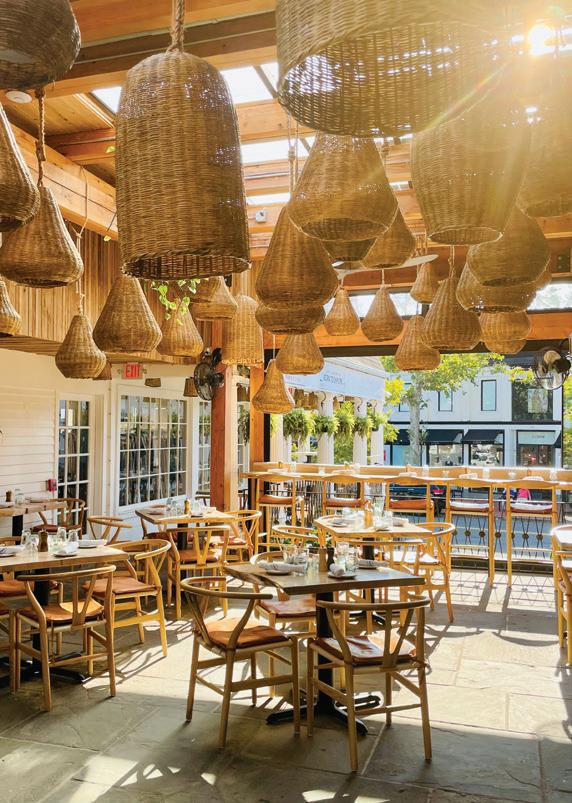
Shrimp “shooters,” grilled shrimp speared on bamboo picks/ skewers, rest in glasses of bright mango sauce, an Insta-worthy shot. The shrimp were succulent the day we tried them, but the mango sauce was too sweet and one-dimensional. An entrée of halibut collar (how often do you see that on a menu?), deboned, was placed in a bowl of buttery wine sauce with colorful cherry tomatoes, capers and basil. It didn’t come with a starch, as is the style these days, so we ordered roasted fingerling potatoes on the side.
The frîtes are those thin, crisp, pale kind that the French perfected. They come with Wagyu bistro steak, the Angus bacon burger, and the hearty portion of fish and chips. For dessert, Valrona chocolate mousse is topped with whipped cream that matches the mousse in airiness. Espresso and coffee evoked murmurs of “Good coffee.” That’s a good parting sign.




Tiny and loveable, Allium (IG @alliumeatery) is a place where you could eat deliciously at breakfast, lunch, dinner and more. Chef Michelle Greenberg worked in the kitchens of Chefs Tim LaBlant and Bill Taibe, and you can see their seasonal and sustainable influences, but her style is her own. The menus change with seasonal availability, and Allium’s youthful mood changes with the day. Whether you dine in, takeout or grab some items from the case (duck rilettes, soups, salads, rotisserie chicken), you are in for a treat. Oh, like a buvette, Allium takes a page from the French with a pre-happy hour of wine and snacks, like the namesake Allium dip.

It’s pronounced “Choco-lottery,” and when you open the door to this little shop on Church Lane, you’ll realize you’ve struck the jackpot for holiday gifts. At Chocolatieree (chocolatieree.com) prepare to order boxes of hand-crafted, single-source chocolates for everyone on your gift list. Laureen Haynes, who goes by the nickname “Ree,” creates shiny molded chocolates filled with ever-changing flavors of ganache (she uses organic fruits as available). Chocolatieree’s most popular chocolate is the salted caramel, and it’s always in the shop’s case. With a twenty-two-year background in science and career in health care, Haynes says the shop is a passion career, inspired by a trip to Ecuador, followed by studying in Belgium to be a master chocolatier. There are no preservatives or emulsifiers in these chocolates, so the shelf life is short—meaning enjoy them now. Or do as some of her customers do: store them in your wine fridge. Wine and chocolate do pair nicely.
With its warm white walls and arched mirrors, The Cottage (thecottage.kitchen) has a soothing and enveloping feel that matches the relaxed luxury of the seasonal New American dishes Chef Brian Lewis and his team create. They craft well-sourced ingredients into spiritual moments. Plates are works of art, plays of color, texture and, most important, taste. During the holiday season, venison and chestnuts are likely to be on the menu in unlikely ways. If foie gras is on the menu, order it. Foodie alert: The Cottage’s brunch is special, too: lobster Benedict, duck confit hash with Millstone farm eggs or duck eggs any way you want them. Be prepared to pay for the pleasure of dining at The Cottage, but it will be worth it.









Westport has chefs. Serious James Beard Award–nominated and finalist chefs. Ones with restaurants in a Michelin guide. It also has a younger generation of chefs who’ve worked with these local stars and have started places of their own. That adds up to ingredient-driven New American food in relaxed and friendly settings.
Chef Bill Taibe’s seafood restaurant and bar, on the Saugatuck River, is where the cool foodies hang. People swoon over Taibe’s gutsy, season cooking, and his use of well-sourced ingredients at The Whelk (thewhelkwestport.com). Those signature deviled eggs topped with fried oysters are still a favorite. There’s a humor to Taibe’s cooking, the way he updates a retro dish like fish sticks, using sustainable pollack served with brown butter tartar sauce and spicy slaw. Shrimp and grits never fails to soothe. Desserts are homey, like chocolate pot de crème and almond cake with amaretto brown butter. P.S.: Taibe’s other restaurants in Westport are Kawa Ni and Don Memo in Westport, and Artspace Café in East Norwalk.
When you’re in the mood for something different, trust an expert.

Next to the Westport Country Playhouse, Gabriele’s Italian Steakhouse (gabrielesofwestportct.com) opened about a year and a half ago. The bar has rich, polished, wood-paneled walls that aren’t oppressive because of the big glass window between the bar and the dining room. It’s excellent for people watching. Order a glass of sparkling wine and oysters on the half-shell with ossetra caviar and people will be watching you
The bar at Hudson Malone (hudsonmalone.com/westport) feels like it has been there forever—a dark-wood bar rises high up the wall, filled with glowing bottles, and the surrounding walls covered in framed photos and magazine covers. There’s a neighborhood feel, and even if they don’t have happy hour, the drafts are reasonable, and the bacon cheeseburger, featuring a Pat LaFrieda patty, comes with fries good enough to order on their own. The ever-comforting mac-and-cheese here is orecchiette with spinach and bacon and lots of cheesy sauce. Although it feels like it has been around forever, Hudson Malone is only in its second year in Westport. It simply has a way of fitting in easily.










Like the name says, this is a friendly place, and that’s what we want at the end of the day. Amis Trattoria (amistrattoria.com) has an industrial feel—with the long stainless-steel bar, exposed brick walls and high ceilings—that is countered by the welcome of the staff. The bartender places warm olive oil–drenched rosemary foccacia before you and offers to make an off-the- menu cocktail, his special spicy jalapeño margarita with a touch of smoky mescal. Holiday stress be gone! Happy hour is from 4 to 6 p.m. with deals on their most popular items, such as the crispy eggplant with potato croquettes. We weren’t the only ones ordering the most excellent fries, topped with melted pecorino cheese and black pepper. You leave Amis wanting to come back. The bartender suggested we return for Wednesday pasta night.
Whether celebrating a holiday or enjoying Sunday, Westport has two of our favorite brunch places.

Smack on the edge on the Saugatuck River, Rive (rivebistro.com) is a bright, window-filled bistro run by a seasoned French restaurateur. Brunch is served on Sunday. The eggs Benedict are straight-forward (poached eggs, Canadian bacon and real hollandaise). Nordic salad with smoked salmon, shrimp, hearts of palm, fresh dill and crème fraiche dressing is a customer favorite. Pro tip: Saturday’s lunch menu has fewer eggs but more options, including shrimp and avocado salad in citrus dressing, and moules frîtes Provençal.
With water views from almost every seat and a coastal-inspired menu, La Plage (laplagewestport.com) offers contemporary casual upscale dining with a focus on local and sustainable ingredients. It’s run by the Delamar and Artisan group, with Chef Frederic Kieffer at the helm. Brunch is served a la carte, Saturday and Sunday, with choices ranging from avocado toast with a sunny-side up farm egg to a raw bar. The crab cakes Benedict call our name. The brunch bread basket with roasted strawberry butter is a must order. And it won’t hurt any of us to share the superfood chopped salad.
The deets: Dry-aged for twenty-eight days, and simply seasoned with sea salt and fresh-ground black pepper, before being grilled to the guest’s specifications; seven cuts, filet mignon, and bone-in filet, NY strip, tomahawk rib eye and porterhouse for one or two. Sauces: four (our favorite, the green peppercorn). Crazy rich add-ons: lobster tail alone or with crabmeat, or Oscar-style.
BLACKSTONES STEAKHOUSE PARKER. MANSIONFairfield County has four Blackstones (blackstones steakhouse.com). These popular steakhouses offer all the classic dry-aged cuts, and sides like







Parker. Mansion (parkereatery .com/westport) in Saugatuck, perched perfectly alongside the river, ten ounce petite filet mignon with julienned vegetables— served without potatoes (order fries on the side). In warmer weather, be sure to snag a seat on the upper deck, which overlooks the water.




Chef Brian Lewis’s Japaneseinspired restaurant, OKO (okokitchen .com), received the distinction of being named a Michelin New Plate Establishment in 2021. OK, it was the Rye location, but Michelin doesn’t cover Connecticut. But the level of craft and quality of ingredients and innovative ways of bringing flavors and textures together are at the same high level. Chef Lewis breaks us out of our comfort zone, and we’re rewarded with unimaginable taste sensations. This time we’ll trying the uni toast, the duck and foie gras gyoza, and the red king crab with chili butter and red miso. Eating here is a privilege, even for the privileged.
The Sumo Boat for two (twenty pieces of sashmi, twelve pieces of sushi and two signature rolls) will comfort anyone with a fear of not ordering enough. Along with full entrées, Pink Sumo (pinksumoct .com), a cozy subterranean downtown spot, has several ramens on the menu. Noodles and warm broth equals total comfort. Of course, it’s not a bad idea also to consider the happy hour, which takes place daily, from 3 to 6 p.m.
Round them up in the car, drive through the back roads of rolling hills lined with stone walls. Destination: Not too far, but far enough, to enjoy a cute place for lunch.



Basso (bassobistro cafe.com) has a special place in our hearts because we drove to it in Norwalk for years, and now it’s right in downtown overlooking Jesup Green. They serve tapas and large plates, wood-fired oven pizzas and paella, both traditional Valencian style and vegetarian. Later in the night, Chef Renato joins the band.
ham, cured for thirty-six months, from the leg and loin of a black-footed breed of pigs that are fed acorns. For dessert, pantxineta is a whippedto-order custard over orange marmalade and a flaky cookie.






was called “Grub’s”), the building was saved from the fate of Positano across the street (spec house development) by a group of local community members. It was a full-circle Westport moment. After all, back in the early 1980s, Kenny Montgomery (a.k.a. “Grub”) left $500,000 to the Westport YMCA. We think he’d approve of the new place.
Baldanza at the Schoolhouse (baldanza restaurants.com) is set in an antique Schoolhouse in Cannondale Crossing in Wilton. It serves daily brunch and dinner, with a focus on fresh vegetables, pastas and a house-made veggie burger.
Further up the road in Ridgefield, Luc’s Café (lucscafe.com) is charming and cramped in a Parisian café sort-of way with an all-day menu featuring onion soup, housemade pâte, cassoulet and wine, of course.

0rder up a bottle of Tempranillo, and remember that trip to Spain. De Tapas (detapasrestaurant .com) is a casual, contemporary temple to tapas and paella is the real deal. The chef/ owner is from Barcelona, but you don’t have to wait until 10 p.m. to eat. The light potato tortilla is made to order and the octopus with homemade chive mayonnaise is succulent. The star of the tapas selection is the sliced-to-order Iberico
Bacon, egg and cheese breakfast sandwiches are once again luring Westport’s beach community to gather in and outside Old Mill (oldmillgrocery.com), a little one-story wood building on Hillspoint. But now, under the management of TGB, the Granola Bar folks, breakfast includes avocado toast (with optional smoked salmon topping), espresso drinks and healthful smoothies. Continuing through lunch and dinner, they serve sandwiches, wraps and twelve-inch pizzas. The market carries the basics, like eggs, milk and butter, too. After decades of being operated as Elvira’s (old-timers from the 1950s through the 1970s will remember when it
An Italian restaurant across from the train station, Tarantino (tarantinorestaurant .com) has been run since 1994 by a family of established Fairfield County restaurateurs who hailed from Puglia. On a cold winter night, a steaming bowl of minestre pasean— escarole, bean and sausage soup (with a little grated Parmesan on top)—defines comfort. Of all of Maria’s homemade pastas—cavatelli, gnocci, fettuccine and ravioli— it’s the pappardelle al ragu de ossobuco, wide long noodles with a sauce of braised veal and vegetables, we order again and again.





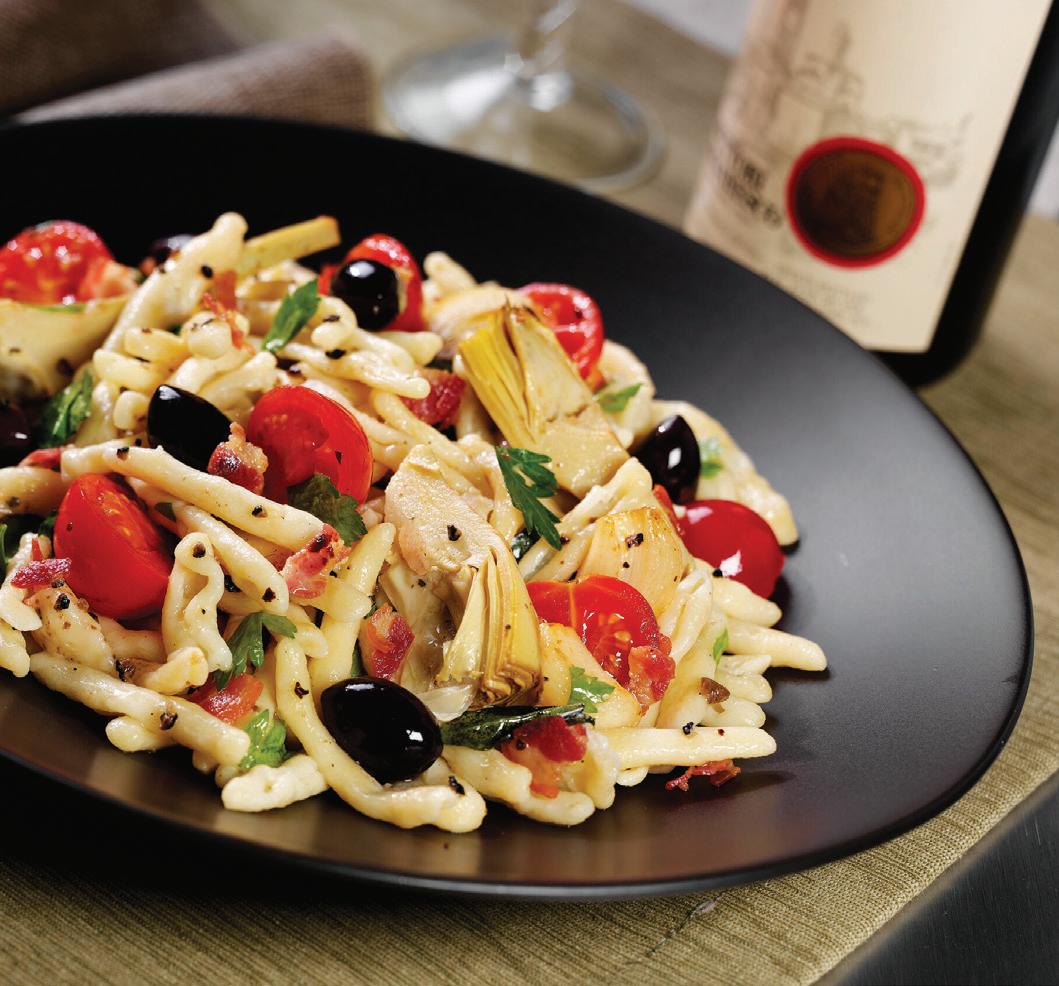






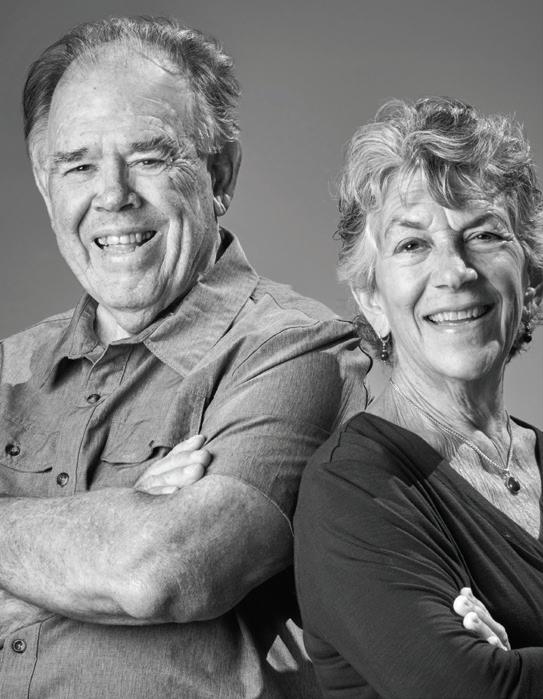
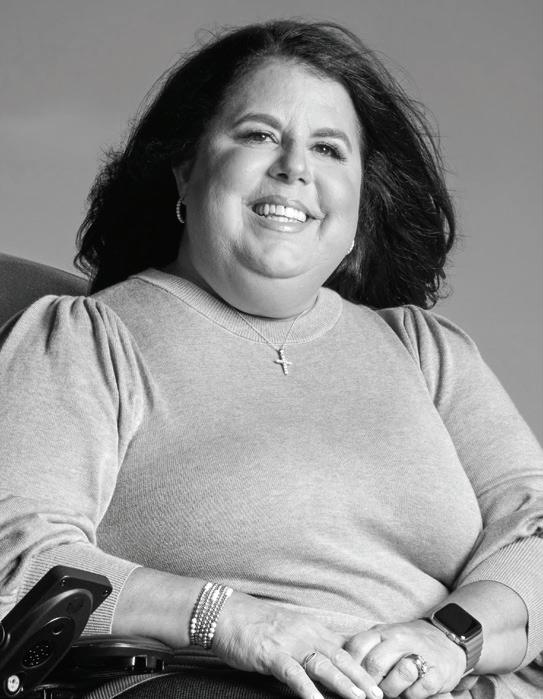
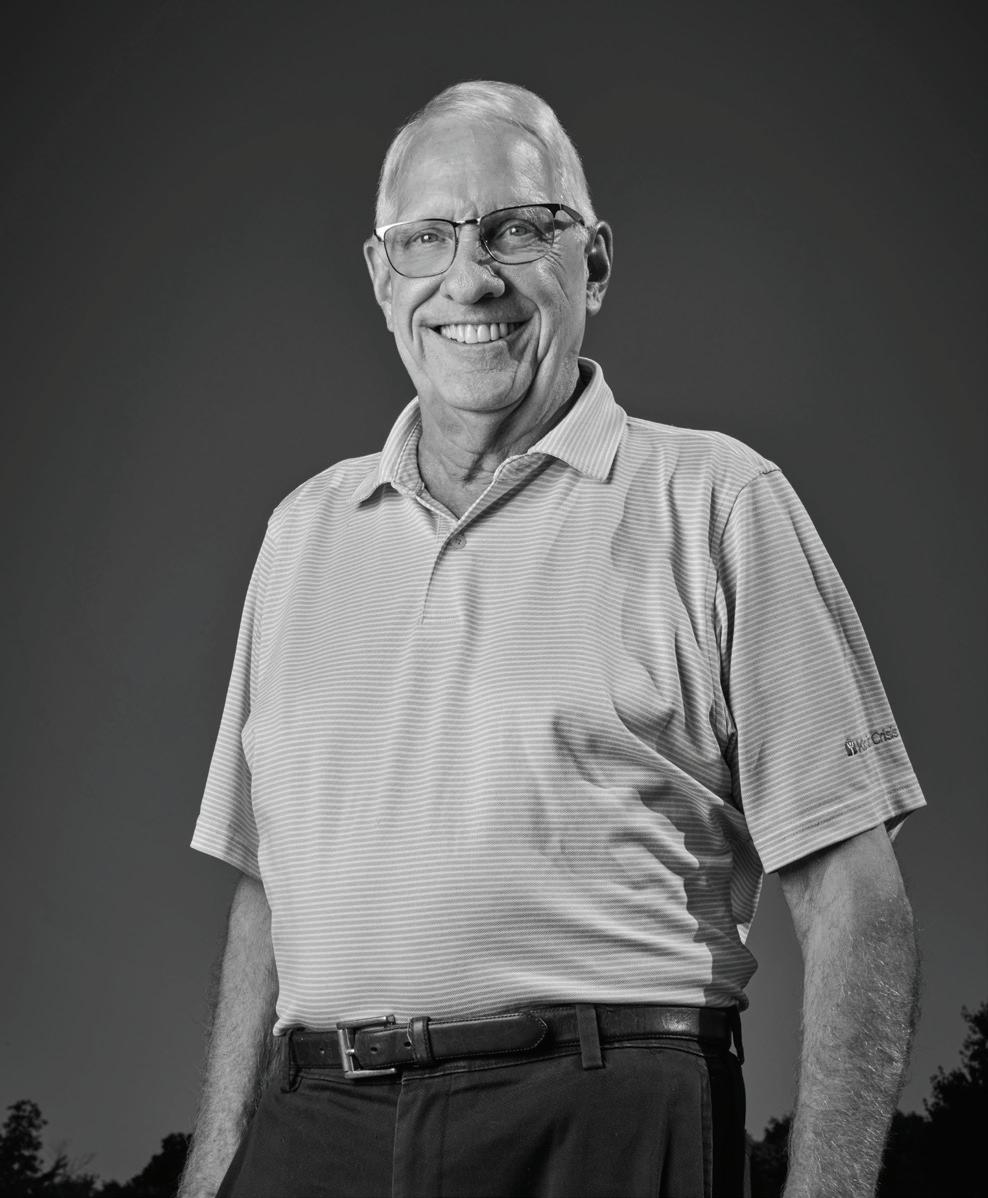
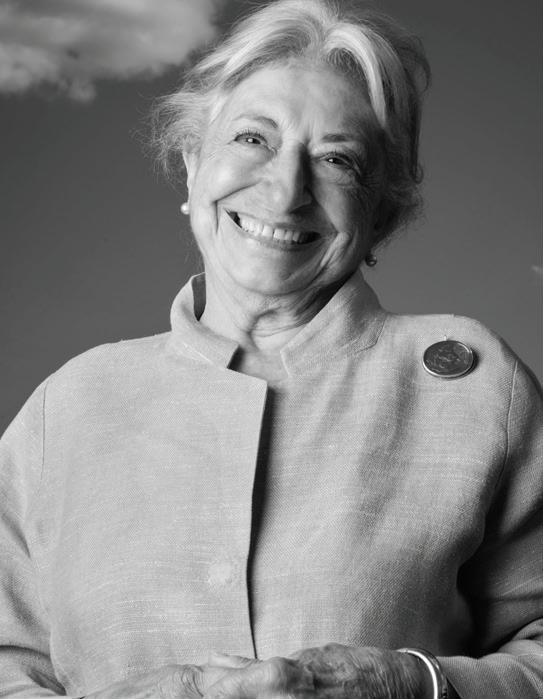

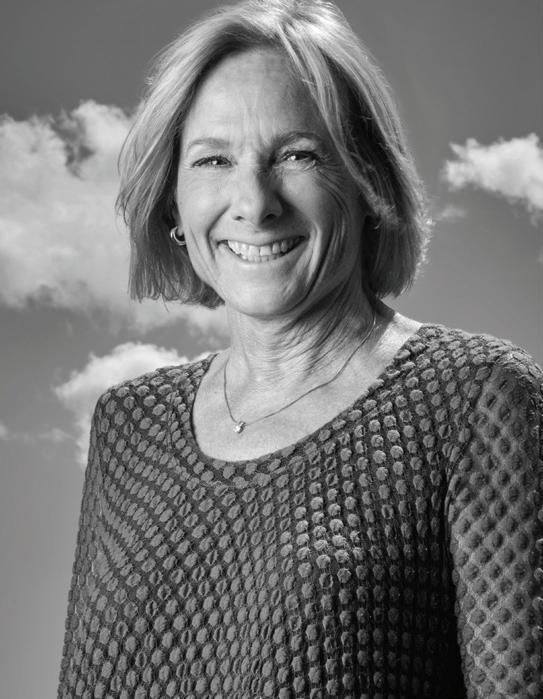
 Nina Lindia Saskia
Nina Lindia Saskia
It’s our favorite time of year at Moffly Media— the time when a warm glow emanates from the pages of our Light a Fire issue. It comes from the Fairfield County residents who spend all year working tirelessly to help their neighbors, improve our towns and make the world a better place. They rarely have a chance to sit still and bask in the glow they have created. We, with the help of your passionate nomination letters, can give them this one moment to shine before they return to protecting children’s mental health, delivering food to the hungry, offering homework clubs and music lessons to immigrant children, making our towns easier to navigate for those with disabilities, buoying the spirits of breast cancer survivors, resettling refugees, preventing abuse, preserving the glorious land around us, championing the arts, building synagogues, bringing together our communities and saving lives. Take a moment and give them your full attention. They just may spark something in you that will land you in our Light a Fire issue one day.
“I started volunteering at twenty-two, when I moved to New York,” says Old Greenwich resident Nina Lindia. “For the first time in my life something broke my heart enough that I wanted to see what I could do about it.” All the vision-impaired residents astounded her. “I couldn’t imagine navigating the city without the power of sight,” she says. Nina began volunteering with a youth program, and then something magical happened. “Volunteering literally solved my own problem.
I witnessed how powerful it can be,” recounts Nina, who joined every committee she could when she moved to Greenwich. “Each was another opportunity to learn something,” she says. “The first thing I ask people I meet is: ‘What breaks your heart about the world?’ I always have a recommendation for a great nonprofit that will unbreak their hearts. I’m not
necessarily someone people come to for advice, but in this category I am. It’s a wonderful feeling.”
Nina is cofounder of the organization Pitch Your Peers, which grew out of a simple observation. “Donation requests usually start with: ‘sorry to ask’ and ‘no amount is too small,’” she says. “That’s a terrible pitch! I thought what if we create a forum in which we can pool resources, without a lot of red tape, one meeting a year, with the notion of giving where you live. Members each give $1,000 annually and in addition pitch their networks: ‘I’m going to ask you for $2,000 and give you really good reasons why.’” If she gets a no, Nina asks what the potential donor is passionate about, so she knows for the future. “I wanted to diversify the portfolio of how we ask for donations,” she explains. Pitch Your Peers raised $10,000 in one day for Ukraine. New chapters are sprouting up across America.
“Nina is a force to be reckoned with. When she sees a need, she looks to fill it. As a lifetime resident of Greenwich, Pitch Your Peers supporter and close friend of Nina’s, it’s so inspiring to see how she harnessed the power of women to make a very real and hands-on impact. Starting a movement is never easy, but Nina has done it with intention, humor and grace. With the help of some good friends who believe in the vision of collaborative giving, informed philanthropy and volunteerism, Pitch Your Peers quickly went from an idea to reality. Since its inception, PYP has expanded from Greenwich to Chicago and Seattle Nina is heavily involved with both to ensure their success. She also passionately supports many other nonprofits. Her gratitude for life shines through in everything she does!”
As a breast cancer survivor, Nina is also a champion of the Breast Cancer Alliance. She cochaired its 2019 luncheon, which shattered all records with a sold-out event of 1,100 people and $1.6 million raised.
“One way we can all give back is an intangible way. If you care about an organization and the community it supports, set a great example. I genuinely care about the population of global breast cancer survivors, and I try to set a great example for people who are newly diagnosed,” says Nina, who had a double mastectomy and numerous rounds of chemo and radiation. “I want to help them to not be terrified, to not give up on themselves. I’ve been through it all, and I’m full of joy.” She adds, “Friends are so important to me. I want to keep helping them unbreak their hearts.” »


“Steven and I grew up in families with a tradition of helping others,” says Sandy Soule. “My parents were refugees of the Holocaust and were founding members of Larchmont Temple. We’d been in Greenwich over forty-five years when the opportunity came up for me to help build a new synagogue. We dedicated the arch in the synagogue in memory of my parents, so I would say we were
“
continuing a family tradition.” Sandy is also involved in Jewish Family Services. “There is a saying: To those who much is given, much is expected,” she says. “Steven is still very busy running his business, but when I retired, it was our time to start giving back. It’s really important to us.” Steven concurs: “Watching what Sandy’s family went through and what they did, you have no choice but to do this.”
Sandy serves on the board of Greenwich Reform Synagogue and is copresident. “We built a new synagogue on Orchard Street in Cos Cob. It’s amazing,” says Sandy, who also serves on the board of JFS of Greenwich. “Jewish Family Services has really stepped it up since the Afghan resettlement program started,” she says, “and now they’re working with Ukrainian refugees as well. Everyone is entitled to a safe place to live.”
During the pandemic, when indoor fundraisers weren’t feasible, the Soules graciously offered to host an outdoor event for JFS. “Since we live in paradise, we are very happy to share,” says Sandy. The first event was a success and attendance tripled at the next. First Presbyterian Church was one of JFS’s community partners in its resettlement efforts. “When Christians and Jews get together to help Muslims, that’s a very special moment,” says Sandy.
Steven became involved with the Mill River Collaborative through his company SB&W (a custom components manufacturer) and First County Bank’s philanthropic foundation. “They have made a commitment to the community that is wonderful to be a part of,” comments Steven. “Mill River is just becoming what it has potential to be.” Sandy adds, “It used to be full of rusting shopping carts and now it’s magnificent.”
At the Soule’s annual Fourth of July party, they request food donations for Neighbor to Neighbor, rather than hostess gifts. For bar mitzvahs, they give one check to the child and one for a charity of the child’s choice. “The kids feel empowered and engaged,” says Steven.
Steven quips: “To be alive and to be retired!” Sandy adds, “I would hope for a fact-based reality, recognizing women as human beings with minds of their own. Needless to say, I’m a very strong supporter of Planned Parenthood. I signed my first pro-choice petition when I was pregnant with our daughter, who is now forty-six.”
For the past fifteen years Sandy has served on the JFS of Greenwich board of directors, including ten years on the executive committee as secretary. In both 2021 and 2022, Sandy and Steve graciously hosted our annual fundraisers at their Riverside home, with close to 200 people in attendance. Their dedication to our growing social services agency is unmatched.”
RACHEL KORNFELD, CEO, JEWISH FAMILY SERVICES OF GREENWICH“I was very lucky to go to a high school with so many resources,” says Darien resident Saskia Zimmerman, a firstgeneration American. “I know that when my parents immigrated [from El Salvador] to the United States, they worked very hard to provide me with the best possible education within their reach. I had the opportunity to take challenging classes [at Darien High School], to learn to play the violin, to fence, to participate in many extracurricular clubs and activities. Not everyone has that good fortune. That’s why I worked with immigrant children at Building One Community (B1C), because they should also have those same opportunities.” The kids served by B1C, an organization focused on the successful integration of immigrants and their families, attend schools that often don’t have the resources Saskia benefitted from, and knowing that inspired her to make a difference.
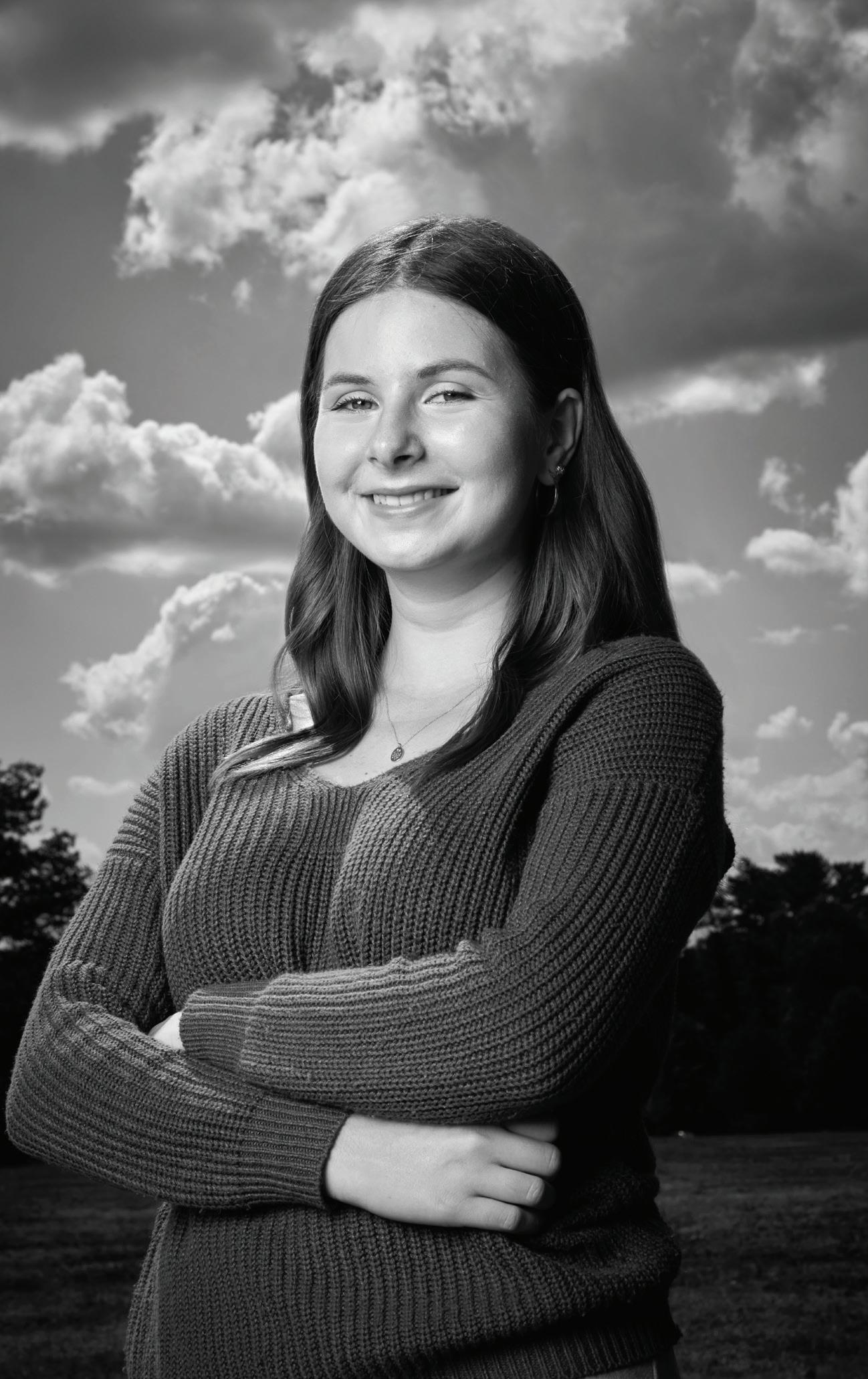
During high school, Saskia volunteered by offering academic tutoring and violin lessons, and she also lead a Homework Club. Last summer, she developed a summer STEAM Club for elementaryschool-age children at B1C. “I created lesson plans, led hands-on activities,
and fundraised for all the materials,” she explains. “I also enlisted one of my older students to help me run the club, so she could give back to the community as well. The children weren’t the only ones who learned. I discovered what it feels like to create and pitch a program, along with how hard it is to be on the other side of the classroom breaking down complicated STEAM topics in a way that even Junior, the youngest student fresh out of kindergarten, could understand. I had never seen a class more eager to learn. I was constantly impressed by their small hands furiously scribbling notes and their engagement. The success of the camp was very rewarding and reinforced my belief that equal access to education is something every kid deserves.”
“I hope that the kids I help grow up to help other kids, and I hope B1C is able to continue to provide the means through which the bond is formed,” says Saskia. “I hope volunteers at B1C continue to help community members learn the skills that will give them the best chance at success in this country, while volunteers deepen their understanding and appreciation of other cultures.” »
“Saskia’s commitment to B1C, and what she has accomplished in her 215 hours of volunteering since 2019, have exceeded our expectations for a youth volunteer. Saskia has volunteered to teach immigrant adults English and tutor youth immigrant students in math. She is also one of our most diligent Homework Club Leaders. Saskia volunteered to run the STEAM summer camp at B1C. She raised the money for the camp through a GoFundMe campaign she created and also used her own birthday money to make supplies available to the kids in her class. Undoubtedly, Saskia’s volunteer work has not only impacted our immigrant children’s lives but also B1C’ s success. ” —LORELY
PECHEB1C
Greenwich Public School PTAs, GPS Building Committees, Junior League of Greenwich, United Way of Greenwich, American Red Cross ( Metro NY North ) , League of Women Voters, First Selectman ' s Advisory Committee for People with Disabilities
“My parents instilled the importance of giving back,” says Steph Cowie.
“Whether they were coaching teams, serving as volunteers for our town or various organizations, we grew up knowing volunteerism should be a part of our day-to-day.”
In January of 2018, Steph suffered a stroke to her spine, which caused paralysis from the waist down.

“Faced with undoubtedly one of the most difficult personal challenges, my life and our family’s life changed dramatically,” says Steph. “Unable to continue my thirty-year professional career, I found that volunteer work became the outlet I needed and carried me through some of the difficult times. Through my volunteer commitments, I was able to adapt and continue to make a difference. Volunteering will always be a part of my life. I continue to volunteer, because I enjoy being with people and making even the slightest difference in a project or a person’s life.”
“I have been so fortunate to work with so many wonderful organizations over the last twenty-one years,” says Steph, who was the recipient of the Greenwich PTA’s Lifetime Essence Award and served on the boards of the United Way and American Red Cross.
“My lens seems very different now than it was previous to my stroke. Like so many, I was unaware of the inadequate services, lack of accessibility and inclusivity in our community for those with disabilities,” she explains.
“Several years ago, I became the vice chair of the First Selectman’s Advisory Committee for People with Disabilities. I have learned so much and have put all that to good use.”
Steph now directs most of her volunteer time to infrastructure in Greenwich, advocating for the town to be Americans with Disabilities Act-compliant in all schools and public spaces. “We just celebrated the ADA’s thirty-second anniversary at the new— and now ADA-compliant—Greenwich High School Cardinal Stadium,” she says. “I couldn’t be more proud to have been a part of this improvement for all to use.”
“I hope that Greenwich continues to work together—all town departments and the public—to better the lives of those with disabilities by making public spaces and buildings inclusive and accessible. We are all only temporarily able.”
“Steph’s passion for philanthropy is infectious, and that has never been more apparent than it is today as she struggles with her own physical challenges and still finds ways to help others and offer them support and encouragement. Steph has a deep passion for life, which permeates all that she does, making her a great messenger of endless possibilities. While she has held many leadership positions, Steph pours as much energy into working behind the scenes as she does leading the way.”
Domestic Violence Crisis Center, Westport Country Playhouse, New Canaan Chamber Music, New Canaan Abuse Prevention Partnership
“As a community relentlessly working together with our nonprofits, we can break cycles of abuse, addiction, hunger and poverty,” says New Canaan resident Bob Doran.
“We can provide education, skills and tools for people to be in control of their own lives. The work of our local nonprofit organizations in the trenches, at their best, transforms lives. The people who are reached by those services and are better for it transform our communities. That is inspiring.”
Doran is active in numerous nonprofit organizations in Fairfield County— Domestic Violence Crisis Center (advisory board), Westport Country Playhouse (trustee) and New Canaan Chamber Music (founding board member)—and also is the volunteer head of New Canaan’s Channel 79 and a founding member of New Canaan Abuse Prevention Partnership.

As host of the Talking About It podcast, Doran is dedicated to preventing abuse, promoting healthy relationships and reducing the stigma around behavioral health issues.
“We need to talk openly about the issues our neighbors face,” says Doran. “Our communities are neither their healthiest nor their strongest if one of us is in need. I made a conscious decision many years ago to not be a bystander. Instead, I try to move the needle as an advocate for change— actively and respectfully speaking out loud about issues affecting our communities. By being a visible advocate—writing op-eds, producing podcasts, speaking publicly and working with nonprofit leadership—I look to raise awareness of important issues, remove the stigma of being in need and give people a voice and a language to ‘talk about it.’”
Doran adds, “I work with many nonprofits on strategic planning and
engagement to define ‘Purpose’ and share their compelling stories.”
“I hope organizations find their Purpose—with a capital P,” says Doran.
“I would like to see organizations do the unconventional and set aside their ‘Mission and Vision Statements.’
I find that most board members, staff, volunteers and clients don’t know them anyway. ‘Mission and Vision’ narrow our focus in ways that constrict peripheral vision; like putting blinders on a horse, you can only see what’s in front of you. Solutions are invariably found around corners. When we look through a Purpose-driven lens, our stories are more compelling, everyone is more engaged, difficult and divisive choices become constructive dialogue, the path to success is clearer, and we make a greater impact in the world.” »
“
Bob Doran embodies the true essence of why one dedicates their time to volunteering. While many raise a hand from time to time in support of a cause that is near and dear to them, Bob raises both and jumps in, feet first. Bob has done so much to lift countless lives through his leadership and to provide a path forward for those who might not otherwise find one.”
TUCKER MURPHY, ADMINISTRATIVE OFFICER, TOWN OF NEW CANAAN“
As an innovative educator and principal of Stamford High School and Brien McMahon High School, Suzanne demonstrated exceptional compassion, connection and leadership on behalf of students and families. She has been an impactful speaker advocating for Teen Talk programs throughout Fairfield County. Countless students have benefited from mental health services due to Suzanne’s commitment and prioritization of this service.
It’s impossible to quantify how many children’s lives were saved due to her tireless effort to assure funding and program availability year to year. Since retiring, she continues to share her expertise and passion as a Kids in Crisis board member.
As part of the Substance Misuse Prevention Task Force, Suzanne is helping to build a campaign to educate families and youth on the dangers of marijuana use. Her work has a direct impact on the health of today’s youth.”
DEBRA KATZ, KIDS IN CRISIS, DIRECTOR OF OUTREACH AND COMMUNITY INITIATIVES“When I was the principal of Brien McMahon High School in Norwalk, my students were the recipients of a Kids in Crisis (KIC) donor-funded Teen Talk counselor,” recounts Suzanne Brown Koroshetz. “This masters’ level, compassionate counselor helped many students navigate difficult personal and school-related issues.” The Teen Talk counselor augmented the school staff by providing confidential individual, group and family counseling.

“She identified at-risk students and families flying under the radar and reached out to students experiencing depression, anxiety, substance-use struggles, and trauma- and conflictrelated stresses,” says Suzanne. “She was an angel who arrived to help my kids. I believe she saved lives.” Suzanne now has the time to support the wonderful organization that did so much for the students in her care. “While Teen Talk is a vital component of KIC, the organization does even more to support children and families,” she adds.
Suzanne now serves on KIC’s board of directors. “What a gift to join a group of dedicated board members and remarkable staff. And to be able to ‘officially’ represent an organization that has meant so much to me for a long time,” she says. Suzanne is cochair of the program committee and works with staff, fellow board members and volunteers. “Our role is to support KIC programs and stay true to the vision and mission of KIC,” she explains. “The programs we directly support include Safe Haven, Light House, Helping Kids Thrive (KIC’s webinar), Outreach and Community Partners.”
“I wish for KIC’s incredible staff and amazing volunteers to continue to have the energy and compassion and all the funding needed to reach the KIC vision: a community where all children are happy and safe,” says Suzanne. “We are working to build healthy communities where children and families can thrive— with prevention, counseling and crisis services available twenty-four hours, every day.” Suzanne continues: “This work is so important. It’s hard to be a kid today, and many families are struggling. It is a privilege to support KIC values as the staff works to welcome all people with respect and kindness, by responding quickly and thoughtfully, while bringing strength and compassion for the benefit of children.”
Westport resident Andrew Wilk retired as executive producer of Live From Lincoln Center in 2019, but there is no valve to turn off the creative flow generated by this producer/director/ conductor/multi-Emmy-winning brain. “In a show biz career, you do it because you love it, and you want to keep doing it,” says Wilk. “It was my chance to do something with this artsy town that I’m really attached to. Westport has been a wonderful place for our sons to grow up. And part of it is selfish—I want to stay sharp, keep directing, keep conducting, and I don’t want to wake up and stare at the ceiling! Retiring with a unique skill set motivates me to keep at it regardless of any compensation.”
In just a few (pandemic-riddled) years, Wilk has brought a slew of stars and Lincoln Center-quality concerts to Westport. He shared his talent conducting the Staples Pops Concert at the Levitt Pavilion, which led Bill Harmer to inquire if he’d do something for the library. “Something” in Wilkspeak translated to a Malloy Lecture with Broadway greats James Lapine, Stephanie Block and Bill Finn about their show Falsettos (which Wilk filmed for PBS); a riveting speaker series, Andrew Wilk Presents; another Malloy Lecture on Leonard Bernstein; and orchestrating the Booked for the Evening event with Itzhak Perlman. Harmer wisely asked Wilk to join the board. Andrew is now in his second term.
“Part of the reason I moved here was the Playhouse,” says Wilk, who suggested the venue for the Falsettos talk and subsequently brought the Playhouse into homes across America via PBS with his Stars in Concert Series in 2021, featuring Shoshana Bean, Gavin Creel and Brandon Victor Dixon. Wilk is currently brainstorming on a future large-scale production to galvanize support for the Playhouse and bring local performers and Broadway stars together on its stage.
“I would hope that the arts will continue to flourish here, and we revive the Playhouse with community support,” says Wilk. “Our library is beyond ground-breaking, and the community provided tremendous support and generosity for the renovation of the library and construction of its state-of-the-art recording studio, Verso Studios. I hope the Playhouse can benefit from the town’s generosity and enthusiasm like the Library has.” »
“Andrew has been on the Board of Trustees since 2017. During his tenure he has graciously shared his directorial and production talents, while freely opening up his Rolodex to bring in various personalities allowing for world-class programming at the Library, from Bob Ballard, discoverer of the Titanic, to Jay Schadler and Mick Davie, correspondents and journalists, to Itzhak Perlman, world-famous violinist and so many others. He is generous to a fault with his time and talent, and we at the Library are grateful and indebted to him for his immeasurable contributions.”
BILL HARMER, EXECUTIVE DIRECTOR, WESTPORT LIBRARY ORGANIZATIONS
Westport Library, Westport Country Playhouse
ORGANIZATIONS
Westport Library, Westport Country Playhouse
“Shortly after my family relocated to Riverside nearly three decades ago, we participated in what can accurately be described as a type of local barn raising,” explains Mike Miller. “Over six weeks during school break, several dozen neighbors—some with construction trade experience, many without—built from the ground up an entirely new playground for Riverside Elementary School. I enjoyed this experience immensely and knew that when other opportunities to serve our community presented themselves, I would again gladly volunteer and participate.”
Miller began volunteering with neighborhood nonprofits after supporting public school programs for many years. He became very involved with Transportation Association of Greenwich (TAG), which offers specialized para-transit services for the Town of Greenwich, annually providing over 30,000 rides for seniors, the disabled, school-age youth and neighbors with limited resources.
“My career skills—team building, collaboration, organizational strategy, finance and management advisory— that were honed through supporting a variety of organizations experiencing periods of urgent transition, dovetailed well with TAG,” says Miller, who helped the organization recover from the Great Recession. He has served TAG as board member, treasurer and president, for over fourteen years.

During the pandemic, TAG pivoted to focus on its pre-pandemic food delivery program, Feed Greenwich, in conjunction with Neighbor to Neighbor and the Department of Human Services.
“Throughout the pandemic to date, TAG has surpassed 72,000 home deliveries, delivering a cumulative total of over 800,000 pounds of food,” says Miller.
“Mike has been on the board of directors at TAG for fourteen years, starting as a financial advisor, and is currently the board president and CFO of TAG all volunteer positions. Mike is more than a board member. He is a true friend of TAG, doing everything he can to help it grow and become more successful in its mission. He works as many hours as a full-time employee! Mike has been there every step of the way as a mentor, advisor, teacher and friend. His commitment to this organization is one of belief believing that TAG is a truly valuable asset to the Greenwich community. He does anything and everything to make it happen on a daily basis.”
DEB VETROMILE, EXECUTIVE DIRECTOR, TAG“In June, following a competitive bid process, TAG was awarded a $3 million contract, which doubled its annual ridership to over 60,000 and expanded its operating footprint to seven additional communities. It has been a tremendously rewarding experience, working alongside the dedicated people here at TAG who help so many.”
“That our community-at-large maintains its commitment to the many organizations that make such a major difference day after day for our neighbors.”
Originally from Buffalo, Marianne Pollak attended a League of Women Voters meeting when she and her husband moved to New Haven. “The League is nonpartisan and is concerned with the functions of government for community,” explains Marianne, whose enthusiastic engagement in the organization continued to Westchester and then Stamford, where she became president. “The League exposed me to many nonprofits,” she says.
“Because my husband spent so much time working in Asia, we travelled a lot, and I became aware of other people and communities,” she adds. “This broadens one’s perspective. No matter what color, what ethnic background—we are all people, and our needs are the same.”
And Marianne’s parents, avid gardeners, inspired her green thumb and concern for the environment.

Marianne has served on numerous committees in the past thirty years. “I was a founding member of the Fairfield County Community Foundation (FCCF),” she says. She also served on the steering committee of its Fund for Women and Girls. She currently serves on the boards of Soundwaters, FCCF, The Bartlett Arboretum, League of Women Voters and Stamford Garden Club. Previously, Marianne served on the boards of Inspirica, the Connecticut Commission of Landscape Architects and the Bruce Museum and was board chair for the Stamford Museum and Nature Center. She also served on the
Connecticut committee of the Regional Plan Association.
“I think I bring an awareness of the importance of engaging the community and helping the community understand the needs of nonprofits,” she says.
“I hope I’ve helped these nonprofits become stronger organizations. The relationship between the board and staff is crucial. I’ve also encouraged other community members to be more engaged with nonprofits and the government.” Marianne adds, “I hope I have been effective in helping nonprofits who did excellent jobs of meeting their mission to communicate with the public, so that there is a greater understanding of how all of our lives are impacted when needs of the community are not met.”
“Covid has obviously changed our lives in many ways and perhaps even placed more emphasis on the needs of communities,” says Marianne. “As we go forward, how can we be more positive about engaging all peoples and all needs and having a vibrant, exciting community? I encourage people to be engaged in politics in the broadest sense: get out there, serve on a board, try to make a change. People talk about giving back; for me, it’s more about what I’ve gained being on boards. I hope going forward our government roles will be looked at in a more positive, broader way and that people will want to be engaged in their community—whether local, state or broader than that.” »
“Marianne is consistently engaged and dedicated to every organization that she is involved with. She brings strategic insight, thoughtful ideas and questions, consistent attendance, and is an excellent ambassador and supporter for all of her causes.”

“Giving back came to me naturally,” says Harry Day. “I felt I should do anything I can to help organizations that help kids and our citizens in Stamford. I just felt compelled to do that. It made me feel better. I have been very fortunate in many respects—to have great parents, to get into Yale University and Cornell Law School— so I felt responsible to do my best in helping others.”
Day’s service in Stamford and Fairfield County as a whole could fill pages. He served on Stamford’s Board of Representatives for nearly two decades. He has served on the boards of Mill River Park Collaborative, Stamford Emergency Medical Services, Old Town Hall Redevelopment Agency and Smith House Health Care Center. He has been involved with Kids in Crisis for fifteen

years, served as board chair for six years, and continues to be a generous contributor and fundraising organizer.

“I was very proud and inspired during my time at Kids in Crisis,” says Day. “I got involved by first being able to persuade the city of Stamford to contribute.”
Day is currently president of Stamford Museum and Nature Center. “We were able to complete the building of the new farmhouse, which has brought many hundreds of new people to the Center,” explains Day.
“Now we are working on getting the planetarium rebuilt, which will set the Center apart from anything like it in the metropolitan area.”
Day is also president of Stamford Land Conservation Trust, which owns and preserves over 450 acres of land across fifty-seven properties. (A tripling in the twenty years that Day has been involved.) “It’s a huge part of my life,” he says, “and of extreme importance to me.
“Harry is a leader who is professional, effective, caring and generous. Ever self-effacing, Harry is not one to seek the spotlight. He is a listener. He is financially generous, but does so with the belief that quiet and anonymous giving is the best kind. I can think of no other individual who has contributed more to the city of Stamford and to Fairfield County just consider the sheer number of nonprofit and municipal organizations that he has been involved with over so many years. I have no doubt that he will continue his selfless quest to making the city of Stamford more livable, lively, interesting and beautiful with the enthusiasm, perseverance, dedication and graciousness that define Harry Day. ”
I love to save beautiful properties from development. I understand the need to build more homes, but it’s so important to have places people can escape to and enjoy the beauty of.”
“I hope for these organizations to bring people together and allow people to take advantage of their own abilities to learn things, enjoy life and make friends. That’s pretty much it!” says Day. “The Stamford Museum and Nature Center does all of those things and it’s an incredible organization. I’m very proud to be president.” G





Connecticut is arguably the cradle of reproductive rights in America. But we have a dark history that predates our progressiveness. History, it would seem, is repeating itself across the country
 by timothy dumas
by timothy dumas
Connecticut claims Anthony Comstock, if it must, as a native son. Born on a farm in New Canaan in 1844, Comstock was the Gilded Age’s archprude, its pig-eyed morality czar, its obsessive porn hunter with a badge and gun. He viewed himself as “a weeder in God’ s garden.” Others viewed him as “a five-foot ass.” Rather than let his Union Army comrades enjoy his ration of whiskey, Comstock would dump it on the ground. “Seems to be a feeling of hatred by some of the boys,” he noted in his journal. The same journal repeatedly hints at one temptation Comstock himself could not resist: masturbation. “I debased myself. I deplore my sinful weak nature.”
After the war Comstock placed himself rather too eagerly in “the mouth of the sewer”—Manhattan—as a solo anti-smut crusader. He sniffed out erotica’s shadowy marketplaces, purchased hot little items like nude photos and racy playing cards, and marched them over to the nearest precinct house, demanding an arrest. Com stock’s zeal impressed certain influential New Yorkers. In 1872 these wealthy men, J.P. Morgan among them, helped him found the New York Society for the Suppression of Vice. From that perch Com stock swooped down not only upon bawdy novelties, but also upon belly dancing, nude paintings from Europe, classic literary works, contemporary plays (George Bernard Shaw was “an Irish smutdealer”), unclothed manikins, church bingo and “that which we call the love story.”
Comstock, a burly man with flowing muttonchop whiskers, rel ished bursting into book shops and private homes, a gaggle of re porters in tow. Near the end of his life (he died in 1915) he boasted of destroying 160 tons of obscene literature, collaring 3,697 “vile miscreants” and collecting $327,134.30 in fines. He also kept a morbid tally of the people he’d driven to suicide (at least sixteen). Had Comstock’s range extended no further than New York, history would have accounted him a mere footnote. Instead, in 1873, he went to Washington armed with dirty books and sex toys and, dis playing these wares, convinced Congress to pass an anti-obscenity bill of breathtaking scope. The so-called Comstock Law made it il legal to mail “obscene, lewd or lascivious” publications and personal letters “containing any filthy, vile, or indecent thing.” But what was obscene? Postal inspectors confiscated everything from medical texts to Valentine’s Day cards, the latter by the thousand. (Not long after, the Supreme Court said that opening sealed mail required a warrant.)
The Comstock Law also banned selling, distributing and mail ing all literature about contraception and abortion (not to mention mailing contraceptives and abortifacients themselves). These sub jects now fell under the banner of “obscene.” Overnight a boom ing condom trade tailed off dramatically. Discreet ads for abortion providers—“Ladies’ Friend and Doctor”—vanished from city news papers. Medical papers portraying the human body were plucked from the mails. Physicians ceased giving crucial advice about birth control to their patients. What yesterday was acceptable, today was criminal: violating the Comstock Law carried a maximum penalty of five years in prison and a $5,000 fine.
The most fervid enforcer of the Comstock Law was Comstock himself. The U.S. Postal Service granted him sweeping powers as a “special agent,” and he used them with special ardor against women’s rights advocates. He arrested physician and birth control lecturer Sara B. Chase for procuring a syringe that women used to douche after sex (“I am preventing poor families from being bur dened with children they cannot support,” she protested to an un moved Comstock during his raid). He arrested the wealthy society abortionist Madame Restell by posing as an impoverished husband with too many mouths to feed. (Rather than face trial, she cut her throat in the bathtub of her Fifth Avenue mansion.) He tried to ar rest Margaret Sanger, the mother of Planned Parenthood, for selling the birth control pamphlet Family Limitation, but nabbed her hus band instead. (William Sanger spent thirty days in jail after a judge declared that he’d engaged in a “scheme to prevent motherhood.”) Comstock pursued Ida Craddock, a writer of marriage manuals, with a crazed, Captain Ahab-like vengeance. It had been Craddock who defended belly dancing against Comstock’s efforts to shut it down at the 1893 Chicago World’s Fair. Years later, still smarting, Comstock arrested her in New York for circulating “The Wedding Night,” her 1900 pamphlet containing frank advice about sex.
Mississippi passed a law that banned abortion at fifteen weeks of pregnancy. The state’s only abortion provider, Jackson Women’s Health Organization, sued, arguing the law violated constitutional rights established in the landmark 1973 Supreme Court case Roe v. Wade. By a vote of 7-2, the Roe Court held that abortion was legal up to “viability,” the roughly twenty-four-week mark at which fetuses can theoretically survive outside the womb. (Thereafter states could prohibit abortion, except when the health of the mother was at risk.)
Jackson won its suit in district court. It won again in the extremely conservative Fifth Circuit Court of Appeals in New Orleans, which wrote in 2019, “In an unbroken line dating to Roe v. Wade, the Supreme Court’s abortion cases have established (and affirmed, and re-affirmed) a woman’s right to choose an abortion before viability.”
Even so, last September Texas (which also falls under the Fifth Circuit’s purview) enacted an abortion law much stricter than Mississippi’s, banning the procedure at six weeks—before many women know they’re pregnant. To enforce the law, Texas devised a Wild West-style “bounty” system of citizen vigilantes, in which anyone learning of
your post six-week abortion can sue to collect at least $10,000 from your abettors: the sister who drove you, the friend who lent you money, the physician who attended you. If the Mississippi law was unconstitutional, the Texas law must have been doubly so. Why, then, did Texas enact it?
The U.S. Supreme Court’s rightward lurch. President Trump installed three social conservatives, Neil Gorsuch, Brett Kavanaugh, and Amy Coney Barrett, making for six conservative justices in all, a supermajority that some viewed as yearning to restore the moral climate of 1960, if not 1860. Worse, that supermajority seemed ill-gotten. Senate Majority Leader Mitch McConnell had denied Obama nominee Merrick Garland a hearing a full eight months before the 2016 election—too close to Election Day, was McConnell’s fatuous claim—and then without blushing, hastened Coney Barrett onto the Court eight days before the 2020 election. Democrats regarded these events as nothing shy of “theft.”
The seating of this new Court converged with the arrival on its doorstep of Dobbs v. Jackson Women’s Health Organization, the Mississippi abortion case that had lost in two federal courts already. Granted a review before the Supreme Court, Mississippi decided to challenge Roe in

boldest fashion. The state’s solicitor general, Scott Stewart, asked the Court not merely to chip away at Roe by permitting the fifteenweek ban, but to scrap Roe v. Wade altogether. No matter that Roe had been affirmed and reaffirmed; no matter that it was woven deeply into American life. Both Roe and Casey, Stewart argued, were simply wrong. “They have no basis in the Constitution.”
On the evening of May 2 Politico published a leaked draft of the Dobbs opinion. Written by Justice Samuel Alito, the draft signaled the majority’s whole hearted agreement with Mississippi: Roe and Casey must indeed be overturned. Pro-choice Americans reacted to the draft with shock and grief, but also with a touch of magical thinking: surely this was a worst-case scenario; surely Chief Justice John Roberts would step in to forge a compromise whereby Mississippi’s fifteen weeks became the most restrictive allowable standard. (Actually, Roberts tried until the last moment.)
It was not to be. On the morning of June 24, the Supreme Court released its 5-4 decision, little changed from the draft, overruling Roe. For the first time in American history, a firmly established constitutional right had been revoked from the people. Now, as Roberts had feared, a state of chaos reigns in which abortion is essentially murder in some states and perfectly legal in others, and in which the Supreme Court is widely distrusted, and will be for years to come. »
How the stringently conservative Supreme Court got the opportunity to overturn Roe v. Wade
When Craddock was found guilty and sentenced to three months in a disease-ridden workhouse, Comstock “exulted with savage glee,” according to a spectator quoted in Amy Sohn’s book The Man Who Hated Women. No sooner was Craddock released than Comstock arrested her again, on the fraudulent charge of mailing the pamphlet to a minor girl. This time Craddock escaped a prison sentence by committing suicide. Just before she turned on the gas jet in her flat, she wrote a letter expressing the hope that her death would shock people into rethinking the “dreadful state of affairs which per mits that unctuous sexual hypocrite, Anthony Comstock, to wax fat and arrogant, and to trample upon the liberties of the people.”
After Craddock’s suicide, people began to weary of Comstock. “Why don’t you suppress the Bible?” voices shouted, as he lectured in Brooklyn about obscene literature. Not long before Comstock’s own death, the socialist newspaper The Masses published a cartoon that neatly summed up the shifting attitude: A rotund Comstock has dragged a young woman by the collar of her nightgown into a courtroom. He tells the judge, “Your Honor, this woman gave birth to a naked child!”
Comstock may have been a relic, but the Comstock Law of 1873 lived ruthlessly on. Worse, twenty-four states, inspired by the federal law, passed “little Comstock laws” even stricter than the original. Connecticut’s was the strictest of all. Pushed through the state House in 1879 by P.T. Barnum, the showman and sometime politician, this “Act Concerning Offenses against Decency, Morality and Humanity” predictably forbade circulating information about contraceptives; but uniquely, it also forbade their use. Married cou ples could go to jail for employing condoms and diaphragms in the privacy of their bedrooms. And physicians could go to jail for coun seling their use, even when pregnancy would have posed a grave danger to his patient.
None of this is ancient history. Our puritanical law of 1879 per sisted until 1965, when the Supreme Court ruled, in Griswold v. Connecticut, the ban on contraceptives to be unconstitutional. “We deal with a right of privacy older than the Bill of Rights,” wrote William O. Douglas in his majority opinion. In other words, a “right of privacy” is a natural right, a bedrock principle of any free society. But it took Griswold to articulate privacy as a constitutional right in matters of sex and family life. Though the word “privacy” is no where mentioned in the Constitution, the concept of privacy—in the sense of being let alone to live as we choose, without unwarranted government intrusion—is threaded throughout. “Would we allow the police to search the sacred precincts of marital bedrooms for telltale signs of the use of contraceptives?” Douglas asked. “The very idea is repulsive to the notions of privacy surrounding the marriage relationship.”
Here is why Griswold matters so critically today: It laid the foun dation for all privacy cases to come—most notably Roe v. Wade, the landmark 1973 decision that legalized abortion up to “viability,” the
Connecticut enacts the country’s first criminal abortion statute. Stemming from a sex scandal in the town of Griswold (see main story), the statute outlaws abortion by “poison” when a woman is “quick with child”—that is, after she has felt the first kick of the fetus in her womb. The abortionist can be punished by life in prison; the woman who undergoes the abortion is not culpable.
1860Connecticut revises its abortion law, in keeping with a national trend. Now abortion at any stage by any means (herbal concoctions or “tools”) is illegal, unless to save the life of the mother. And now, too, the woman is guilty of a felony.
roughly twenty-four-week mark at which fetuses can theoretically survive outside the womb. (Thereafter states could prohibit abor tion, except when the life or health of the mother was at risk.) All of that changed on June 24, when the Supreme Court handed down its decision in the case of Dobbs v. Jackson (Mississippi) Women’s Health Organization. The Court could have simply upheld Mis sissippi’s ban on abortion after fifteen weeks, as Chief Justice John Roberts had wished, but the five conservative justices decided to go big: They overturned Roe v. Wade and the twenty-odd cases that flowed from it. For the first time in American history, a constitu tionally-established right had been snatched back from the people. Samuel Alito’s majority opinion adopted a tone of barely sup pressed hostility. He offered zero respect for a precedent deeply woven into American society—one that women relied upon for a half century to escape poverty, abusive relationships, troubled preg nancies, and difficult lives, not to mention to preserve their freedom. “Roe was egregiously wrong from the start,” he wrote. “Its reasoning was exceptionally weak.” (In fairness to Alito, legal scholars of all persuasions have picked at the Roe opinion; few of them, however, take issue with its bottom line.) Then Alito reached back to old, male-centric sources to buttress his opinion, including seventeenthcentury English jurist Matthew Hale, who described abortion as “a great crime” but also sent women to death for witchcraft and wrote that rape in marriage isn’t rape.
Supreme Court experts were aghast at Alito’s insensitivity. “The
Anthony Comstock, New York’s chief vice cop, persuades Congress to pass a sweeping obscenity law. The Comstock Act makes it illegal to send “obscene” or “immoral” materials through the mail. The law makes no attempt to define “obscene,” but it explicitly includes anything to do with contraception and abortion. Violating the Comstock Act can land one in prison for five years. Comstock himself rents a post office box in Greenwich in order to entrap New Yorkers into sending material across the border, thus turning a state crime into a federal one, according to Amy Sohn in her book The Man Who Hated Women.
1935The Connecticut Birth Control League quietly— and illegally—opens a clinic in Hartford. Clinics in Greenwich, Stamford and Norwalk follow. But when a birth control clinic opens in Waterbury in 1938, Catholic authorities pressure police to enforce the 1879 statute. The clinic’s founder and two physicians are arrested, though ultimately not prosecuted. The state’s birth control clinics shut down.
States pass “little Comstock laws” that often go further than the federal one. Connecticut’s is the strictest of all. Not only does it regard information about abortion or birth control obscene, but it forbids outright the use of contraceptives. And it punishes an abettor (say, a physician) “as if he were the principal offender.”
Estelle Griswold, executive director of the Planned Parent League of Connecticut, and C. Lee Buxton, a Yale School of Medicine professor and gynecologist, open a birth control clinic in New Haven, hoping to draw legal action. Local detectives promptly raid the clinic and arrest Griswold and Buxton. They are convicted of abetting a crime, and the state Supreme Court upholds both the convictions and the archaic 1879 statute.
opinion feels like it was written by arsonists,” noted Dahlia Lithwick, a lawyer who writes about the Supreme Court. Reva Siegel, a Yale law professor specializing in the Constitution, sent us an article in which she wrote, “The decision so dramatically limits women’s con stitutional liberties that one can almost hear the chants of ‘lock her up!’ from Trump’s supporters.” (In Texas, performing an abortion is now punishable by up to life in prison.)
Then there was Clarence Thomas. In his concurring opinion he raised the specter of the Court “correct[ing] the error” of other cel ebrated privacy cases, including Lawrence v. Texas (2003), which legalized consensual gay sex, Obergefell v. Hodges (2015), which legalized same-sex marriage, and even Griswold, which was sud denly back in the news not as a venerable precursor to Roe, but as a threatened right.
Thus does a straight line run from 1879 to the present moment. Somewhere, the ghost of Anthony Comstock is smiling.
Today Connecticut is regarded as a moderately liberal state. But it overwhelmingly supports abortion rights, with 68 percent in favor in all—or most—cases. (Only Massachusetts, Hawaii and Vermont poll higher.) Ours was the first state in the nation, in 1990, to codify Roe into its own laws, and remains one of only sixteen states to have done so. And in May, before the fall of Roe, Connecticut was first
In the landmark Griswold v. Connecticut, the U.S. Supreme Court declares that Connecticut’s ban on contraception violates the Constitution’s implicit right to privacy, marking the first time the Court unequivocally asserts that right. The decision lays the groundwork for Roe v. Wade.
to pass a law protecting out-of-state women who receive abortions here, as well as those who provide or facilitate abortions.
State Rep. Matt Blumenthal of Stamford got the ball rolling late last year. Noting the bleak tenor of the oral arguments in Dobbs, Blumenthal understood that Roe was probably doomed. “And I wanted to make sure that we in Connecticut were protected,” he says. Working with Rep. Jillian Gilchrest of West Hartford, he con sulted an all-star team of law professors and formulated legislation now known as the Reproductive Freedom Defense Act. (In addi tion to its protections, the act expands abortion access by permitting qualified nurses and physician assistants to perform suction abor tions, the most common kind of clinical abortion.)
New York, New Jersey, Massachusetts and Delaware soon copied us—and then red states moved audaciously to counter these new protections. The conservative Thomas More Society drafted model legislation that would forbid people in abortion-ban states to get abortions in legal states such as ours, and it’s only a matter of time before legislatures enshrine the society’s handiwork into law. Blu menthal predicts a collision between the two sets of laws: It’s wholly conceivable that we’ll see a Texas prosecutor go after a Connecti cut physician. “But we’re not going to shrink from defending our doctors, our nurses, our residents, and people who come here for care,” Blumenthal says. “We’re going to stand up and say, ‘Texas, don’t mess with Connecticut.’” (Zari Watkins, COO of Planned Parenthood of Southern New England, informs us that last year
Connecticut legalizes abortion by order of the U.S. District Court in Hartford. This important but largely forgotten case, called Abele v. Markle, began with Yale law student Ann Hill’s anger at having to choose between an illegal abortion and bearing a child she didn’t want (she chose the abortion). The state reacts to the nullification of its 1860 abortion law by obtusely passing an even stricter law, requiring an Abele v. Markle II to strike it down. District Judge Jon O. Newman’s majority opinion establishes “viability” as the most reasonable line between the rights of the woman and the rights of the fetus, and his thinking will markedly influence the Supreme Court’s Roe opinion.
1972The Supreme Court case Planned Parenthood v. Casey affirms Roe and clarifies its “viability” standard (dispensing with the somewhat muddy trimester scheme). But Casey also permits certain restrictions—waiting periods, parental consent—that make abortion access more difficult. 1975 1990
1973Roe v. Wade establishes abortion as a constitutional right. After the first trimester, however, that right is not absolute: States may regulate abortion to protect women’s health in the second trimester, and prohibit it altogether after viability (which the Court locates at 24 to 28 weeks but is now 23 or 24 weeks) except when the life or health of the mother is at risk.
Texas women, in response to new restrictions, began traveling to Connecticut for abortion care.)
How did Connecticut become a beacon of reproductive rights, when we were once the most repressive state in the union? The story is instructive: Let it begin with Sarah Grosvenor. In 1742 the nineteen-year-old farmer’s daughter from Pomfret became preg nant by her lover, Amasa Sessions, twenty-seven, son of a local tav ern keeper. At Sessions’ insistence, Grosvenor took an abortifacient to do away with the fetus, but the powder merely made her ill. So Sessions hired a “practitioner of physick” named John Hallowell to perform a surgical procedure. Two days later Grosvenor miscarried, and soon after that she contracted a uterine infection, grew fever ish and sank away into death. After an unexplained gap of three years, authorities arrested Sessions and Hallowell—the first known abortion-related arrests in America. For unknown reasons Sessions was let off the hook, but Hallowell was found guilty and sentenced to twenty-nine lashes and two hours’ public humiliation at the gallows. Before he could be punished, he broke out of jail and fled to Rhode Island, never to return.
Abortion was not uncommon in Colonial America. It was toler ated so long as it occurred before “quickening,” the first kick of the fetus in the womb, at four to five months. In 1748 Ben Franklin pub lished an abortifacient recipe—a mixture of mildly toxic herbs—in a widely circulated book of practical knowledge. Numerous popular
Connecticut is the first state to codify the terms of Roe into its own laws, ensuring that abortion would remain legal, prior to viability of the fetus, even if Roe were overturned. Gov. William A. O’Neill, a Catholic who personally opposes abortion, signs the bill into law.
medical books of the era proffered similar advice. So when Samuel Alito argues in his Dobbs opinion that abortion can’t be a consti tutional right, because the practice is “not deeply rooted in the na tion’s history and tradition” (a dubious standard to begin with: was women’s suffrage deeply rooted?), he’s factually incorrect. Though there was ambivalence about abortion because it could be danger ous, the practice was accepted by custom and by common law.
The first criminal abortion statute was enacted in 1821—courtesy of Connecticut. Why us? The immediate reason concerned a reli gious sex scandal in the town of Griswold. In 1817 a middle-aged preacher named Ammi Rogers impregnated a twenty-one-year-old congregant, Asenath Smith, and pressured her to ingest an aborti facient concoction. The young woman fell violently ill but survived, delivering a stillborn baby. Authorities got wind of the minister’s outrageous behavior and took redemptive action: They convicted Rogers of assault and jailed him for two years. Then they passed the historic 1821 statute, which outlawed abortion by “poison” when a woman was quick with child. The law clearly aimed to protect women, not fetuses, since it left in place the understanding that abortion before quickening was legal. (Also, the law punished only the abortionist; the woman was viewed as a victim of schemers like Ammi Rogers.)
In 1860 Connecticut hardened its law to ban abortion at any stage of pregnancy and extended punishment to recipients. The moral
2022The Supreme Court, in Dobbs v. Jackson Women’s Health Organization, overturns Roe v. Wade by a 5-4 vote. No longer a constitutional right, abortion returns to each state to decide for itself. But as Connecticut’s history shows, the will of state officials does not always reflect the will of the people.
2022Anticipating the fall of Roe, Connecticut passes the Reproductive Freedom Defense Act, which protects patients who travel here for abortion care, as well as those who provide abortions or otherwise help patients. The act also expands access to abortion by permitting qualified advanced practice clinicians to perform aspiration, or suction, abortions.
climate around abortion in America had darkened considerably, but an evolving concern for the fetus was only part of the story. In 1857 physicians, led by Horatio Robinson Storer of Boston, embarked on a vigorous anti-abortion crusade that resulted in a virtual na tionwide ban. On one hand, physicians worried about the danger of abortion practiced by numberless “irregulars,” midwives and ho meopaths without formal training; newspapers were rife with stories of young women dying of abortions gone awry. On the other hand, the physicians, almost exclusively men, objected to the irregulars, who were mainly women, cutting into their business turf. (Women lacked the right to vote and so were powerless to counter the physi cians’ crusade.)
Storer believed abortion was murder. Many who held this view, though, did so through a fog of racism. They obsessed about white Anglo-Saxon Protestants committing “race suicide,” as suppos edly inferior stock—poor Blacks and immigrants—procreated with abandon (that is, without recourse to abortion and contraception). Despite the new criminal statutes, abortion in America exploded between 1840 and 1880. An 1870 poll of Philadelphia physicians called it an “epidemic.” At the same time in New York, four hun dred “abortoria” were hiding in plain sight, according to the Times In 1905, as talk of race suicide peaked, Connecticut’s Waterbury Evening Democrat opined, “It would be interesting to know how many native-born American children there would be if native-born
American parents did not transgress the law of God and nature by abortion, infanticide and onanism.”
Though women of all classes, races and religions got abortions, the typical patient was Protestant, married and middle- to upperclass. Usually these women sought to escape an endless cycle of child-bearing and child-rearing, or they’d endured dangerous preg nancies and worried about losing their lives in a kind of pregnancy roulette. (The single young woman “in trouble” made the papers when she died of a botched abortion, but she was a less typical case.) Abortion among Catholics was comparatively rare, because they tended to be poor, and because the Church thunderously forbade both abortion and contraception. Curiously, when Roman Catholic leaders distinguished between the two modes of baby-prevention, contraception was often the greater evil: “To take a life after its in ception is a horrible crime,” New York Archbishop Patrick Hayes said in 1921. “But to prevent life that the Creator is about to bring into being is satanic.”
By the twentieth century Connecticut had shaken off some of its Puritan mud. One notable progressive mud-shaker was Katharine Hepburn of Hartford, mother of the actress, who in 1923 cofounded the Connecticut Birth Control League, or CBCL. This was a coura

geous undertaking. Our 1879 Comstock law was very much alive, and the topic of birth control still possessed an aura of transgression and sin. Then there were the Roman Catholic multitudes. Immigra tion in the late nineteenth century—from Ireland, Italy and Eastern Europe—had flooded the state with Catholics and austere Catholic officialdom, which exerted immense power over its largely Demo cratic flock, including a burgeoning number of Catholic politicians.
Birth controllers like Hepburn brought out the ogre in the Church. Hartford Bishop John G. Murray called contraception a “perversion” and observed that the northern European races, “the finest type of people,” were “doomed to extinction, unless each fam ily produces at least four children.” Francis J. Sugrue, a priest from South Norwalk, assailed birth control’s “lecherous leaders.” Hart ford priest Andrew J. Kelly charged Hepburn with “naked pagan ism.” But the birth controllers remained steadfast, if a little awed by the ferocity of their foes. A CBCL executive informed his colleagues, “Catholic opposition in the state is rising like a tidal wave.”
Republicans, who monopolized the state legislature and tended to be Protestant, had little stomach for social change; they were of the old stock that had won for Connecticut its reputation as “the land of steady habits.” One exception was Epaphroditus Peck, a lawyer from Bristol. He argued before the state House in 1929 that the old Com stock-Barnum statute was “essentially religious legislation,” a claim that seems eerily current, as today conservative Christians lead the charge in banning abortion even in cases of rape and incest. Counter ing the enlightened Peck were myriad voices like that of Rep. Caroline T. Platt of Milford, who claimed that permitting contraception would “open the way for every girl to become a prostitute.”

Connecticut’s birth control advocates succeeded in putting the issue before a shyly amenable public, but that was all—they could not budge the legislative needle. A lively faction from Greenwich, led by Nancy Carnegie Rockefeller and Florence Borden Darrach, responded to that intransigence by opening a clinic in Port Chester in 1932. “At long last Connecticut—almost—had a clinic,” wrote the Pulitzer Prize-winning historian David J. Garrow in his magisterial Liberty and Sexuality: The Right to Privacy and the Making of Roe v. Wade. As it happens, Garrow grew up in Old Greenwich and gradu ated from Greenwich High School in 1971. It is his book that first traced America’s battle for the right to privacy back to a succession of fierce Connecticut women.
In 1935 Hepburn’s friend Sallie Pease, president of the Connecticut Birth Control League, quietly opened the state’s actual first clinic, in Hartford. By 1936 Greenwich, Stamford and New Haven, too, had clinics. Then came Norwalk, Danbury, Bridgeport—and fatally, Wa terbury, the state’s most Catholic city. The Church smoked with in dignation. The clinic was raided. Police arrested its founder, Clara McTernan, along with two young doctors. “Then everything across the state shuts down,” Garrow tells us from his home in Pittsburgh. “Just like we saw in Texas with abortion twelve months ago.” (Garrow
is referring to the Texas law of last September that banned abortion at six weeks. After Dobbs, Texas established a near-total ban.)
As birth control clinics sprouted up around the country, Connecti cut remained dark. Decades passed; finally our state alone banned the possession and use of contraceptives (Massachusetts banned their sale and distribution, but not their use). In 1961 a Connecticut couple and their physician managed to get their appeal before the U.S. Supreme Court, in Poe v. Ullman, but the Court effectively punted: Since there had been no arrest, there was no injury—a decision that curiously discounted the injury of denying medical care to a woman (“Pauline Poe”) who had given birth to three children with fatal defects. On No vember 1 of that year, Estelle Griswold, head of the Planned Parent hood League of Connecticut (as the CBCL was now called) opened a birth control clinic at 79 Trumbull Street in New Haven. On Novem ber 2 she invited reporters to the clinic and cheerfully explained that, in frank defiance of the law, PPLC had begun providing advice and contraceptives to married women. The provocation worked. Upon reading the news on November 3, James G. Morris, a Catholic father of five, worked himself into such a lather that he complained officially to New Haven police, demanding they shutter the clinic and arrest the outlaws. In comments to the press, Morris went full Comstock, comparing 79 Trumbull Street to a house of prostitution. “Marital
relations,” he said, “are for procreation and not entertainment.”
That afternoon two police detectives “raided” the clinic. Estelle Griswold could not have been more delighted. She gave the de tectives a leisurely tour, supplied them with illicit literature, and even directed them to clients who would happily brandish their diaphragms and birth control pills. On November 10 Griswold and Dr. C. Lee Buxton, the clinic’s medical director, were congenially arrested and released on $100 bond each. Thus began the most im portant privacy case in American history.
If Connecticut’s legislature was bizarrely out-of-step with the times in regard to birth control, its courts did not care to recognize it. The Sixth Circuit convicted Griswold and Buxton and fined them $100 each, having rejected their free speech and marital privacy ar guments; the appellate court upheld the convictions, claiming, with unintentional humor, that the state could deter “practices that tend to negate its survival”; and the state Supreme Court blandly agreed with these rulings: the 1879 law had survived a lot of challenges, so why shouldn’t it survive this one?

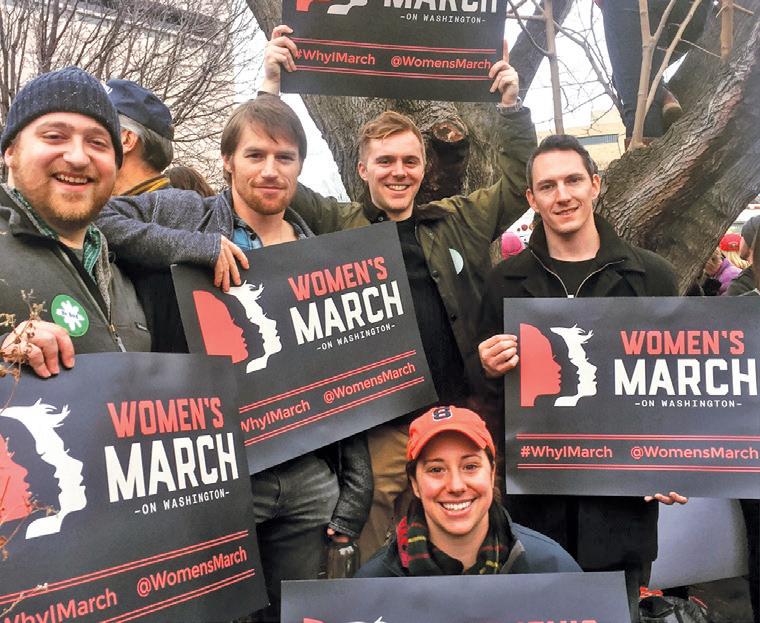


Garrow notes a central irony in all of this: the Catholic control of the Democratic Party that had kept the antiquated law on the books also sealed our date with the U.S. Supreme Court. Connecticut’s re pressiveness had ignited the forces of rebellion.
It is among the saddest photographs ever taken. The black-andwhite image, from June of 1964, shows a lifeless woman lying facedown on the floor of a tatty room at the Norwich Motel—naked, knees folded under her, hind quarters bloodied from a botched abortion. The woman was Gerri Santoro, a twenty-eight-year-old mother of two from the town of Coventry. She was married to Sam Santoro, who had moved the family to California, and who beat Gerri and the girls until they fled back to Connecticut.

Gerri took up with a coworker named Clyde Dixon, by whom she became pregnant. Sam then announced his intention to come East. The thought of him finding her pregnant struck such fear into Gerri that she submitted to Clyde’s clueless doctoring, there at the Norwich Motel. And when she began to hemorrhage, Clyde bolted, leaving Gerri to die alone. A maid found her in the morning.
Mysteriously, the photograph, taken by Norwich police, surfaced in Ms. magazine in 1973 under the headline “Never Again.” Then the photo began appearing on placards at marches. Thus did the appalling death of Gerri Santoro, a farm girl from Coventry, Connecticut, be come a galvanic symbol of the pro-choice movement, a
v. Wade had
Or so it seemed. »
Nearly fifty years later Roe is gone. A few in Connecticut greeted the news warmly. Our Catholic bishops noted that “we have heard many voices cry out for the innocent lives of the unborn” and that America had reached “a most hopeful and encouraging moment.” Peter Wolfgang, who heads the Family Institute of Connecticut, said, “This is the liberation of the unborn child” and vowed to keep working toward a “Connecticut where every unborn child is pro tected in law and welcomed in life.”
Most, however, greeted Dobbs with intense dismay. “It stings—it stings,” says Zari Watkins of Planned Parenthood of Southern New England. “This is about the patients and their loss of access. Abor tion is healthcare. We are denying folks access to basic healthcare— and, yes, it’s devastating.” Danielle Eason of Greenwich, an abortion rights advocate who has served as a “hand holder” to women getting abortions at the Planned Parenthood clinic in Stamford, says, “It’s a slap in the face to women who, for fifty years, had the right to bodily autonomy and agency over their lives.” Now she fears for the mil lions of girls and women in states like Texas, Missouri and Louisiana who lack the wherewithal to travel to states like Connecticut. “It’s an uphill battle they just won’t be able to climb.”
Eason herself had an abortion several years ago at Greenwich Hospital. “My husband and I are both Tay-Sachs carriers,” she says. Tay-Sachs disease manifests itself soon after a child is born, and re sults in catastrophic problems, including paralysis, as the nerves in the brain and spinal column disintegrate. It chills Eason to imagine being poor and living in Texas under the tyranny of that state’s ban.
“If I lived in Texas right now, I’d potentially have to carry that preg nancy to term—which has its own risks—and then give birth to a child who has an inevitable fatal outcome by the time they’re a toddler. And it’s a painful death.” Genetic testing let the Eason family avoid that fate. But the test itself would pose a problem elsewhere. Since it can’t
be done until the eleventh week of pregnancy, states that ban abortion (thirteen and counting) or restrict it to six weeks (Ohio and Georgia) would force upon the Easons a protracted family tragedy.
New abortion laws have already ushered in a period of medical chaos. In Louisiana, a thirty-six-year-old woman was denied an abortion after an ultrasound showed her fetus to be missing part of its skull. In South Carolina, a nineteen-year-old carrying a nonvia ble fetus risked death by sepsis—or merely losing her uterus—when physicians sent her home, because the law precluded extraction be fore the fetus died. In Texas, a woman whose water broke at eighteen weeks—rendering delivery of a live baby hopeless—opted for an abortion, but the law was so vague that no physician would perform it. She was sent home to get sicker—which she did.
“We read about women walking around with dead fetuses for two weeks, because practitioners don’t know how to maneuver in this new landscape,” Eason observes. She does not judge women who have abortions for less urgent reasons than these. “Abortion happens for all sorts of reasons. You can’t pick and choose which ones are valid or not valid. It’s a very private matter, unique to each person.”
Birth control is no longer contested territory in America, though we shouldn’t speak too soon. Efforts are afoot to reclassify certain contraceptives as abortifacients, lending real weight to Clarence Thomas’s threat to undo Griswold. Abortion is another story. The country is hopelessly divided, though a solid majority of Americans, about 61 percent, are pro-choice in all or most cases, according to the Pew Research Center. Surprisingly, given Church teaching, 58 percent of Catholics think abortion should be legal, and 68 per cent were opposed to overturning Roe, believing abortion to be a matter of individual conscience, says the advocacy group Catho lics for Choice. (Protestants, various as their denominations are, diverge sharply on abortion: 60 percent of “mainline” Protestants favor choice, including 79 percent of Episcopalians, while only 33 of evangelicals do. Jews are notably pro-choice, polling at 83 percent, according to Pew.)
About 37 percent of Americans are anti-choice in all or most cases. While a fraction of these would leave Roe in place anyway— in deference to the conscience—the majority of them liken abortion at any stage to the murder of a living human. Indeed, anti-abortion politicians like Ted Cruz speak of Roe as permitting “the deaths of 63 million American children” as if they’d been cut down on the playgrounds of suburbia. No wonder the debate is so poisonous.
“Both sides are controlled by purists,” David Garrow, the his torian, contends. A self-described pro-choice moderate, Garrow thinks John Roberts offered a reasonable compromise in uphold ing Mississippi’s fifteen-week ban yet also wanting to preserve Roe. “It was crystal clear during oral arguments that the chief justice
“EVEN THOUGH WE’VE BEEN VERY PROGRESSIVE AND TRAILBLAZING, THAT COULD SWITCH
A DIME IF OUR LEADERSHIP CHANGES.”
wanted to find some middle ground,” he says. “And you know, John Roberts represents America.”
Polling does affirm that pro-choice Americans grow uneasier about abortion as pregnancy progresses. “For most everything up to ten to twelve weeks, an abortion can be done largely with vacuum aspiration,” Garrow explains. “You don’t have to do a D & E, using curettes and pulling things out, piece by piece. Once you get past about twelve or thirteen weeks, though, it’s unpleasant. There are a lot of pro-choice clinicians who won’t go past sixteen or eighteen or twenty weeks, because it increasingly looks like an actual baby.”
Most of the roughly 900,000 abortions in America annually are performed early. Ninety-three percent occur within fourteen weeks—the first trimester—and the majority of these are accom plished with pills. Only one percent of abortions are performed after twenty weeks. Yet as the ramifications of Dobbs play out, many are revising their willingness for “middle ground” compromise, as they learn, for instance, that fetal abnormalities often go undetected until a twenty-week ultrasound. There are other reasons why people wait to get abortions. Through no fault of their own, some women are slow to realize they’re pregnant, and when they do realize it, a com bination of saving $500 (to say nothing of travel costs) for an abor tion and booking an appointment at a typically backlogged provider pushes out the timeframe exasperatingly.
Meanwhile the anti-abortion movement is embracing ever more extreme tactics. Some Republican-led states, like Arizona and Geor gia, now legally define “personhood” as beginning at fertilization. What do they make of the fact that, in the natural course of things,
as many as half of fertilized eggs fail to implant in the uterine wall? Are these millions of “persons” dead children? And what of the hundreds of thousands of human embryos—or should we say chil dren—locked away in freezers? Where’s their child tax credit?
Most people do agree that abortion raises profound moral and philosophical questions. Dr. Paul Lakeland, an eminent Catholic writer and a professor of Catholic studies at Fairfield University, tells us the Church should drop its “nonsensical” argument against birth control. But abortion? It’s infinitely knottier. “Deep down I think most Catholics understand that sometimes there are compet ing values, and sometimes very hard decisions have to be taken,” Lakeland says by email. “All killing is objectively evil, but there are some circumstances where killing is justified: war, self-defense, and…” He leaves the sentence unfinished.
One thing seems indisputable: the Dobbs decision is increasing the store of human misery in America. As soon as the decision came down, clinics were beset with calls from sobbing women. Women and girls already in waiting rooms were told to their bewilderment that they had to go home. Protests erupted outside the Supreme Court building and in cities across the country. Days later, thousands of protesters converged on the White House, chanting “We won’t go back.”
But nothing could be done. Bans took hold in thirteen states, and ten more may follow. Other states (Ohio, Georgia) went in for re strictions so severe they are tantamount to bans. Then there was Kansas. The state has abortion protections in its constitution, but Republican lawmakers, who vastly outnumber Democrats, sought
…

IN MAY, BEFORE THE FALL OF ROE, CONNECTICUT WAS FIRST TO PASS A LAW PROTECTING OUT-OF-STATE WOMEN WHO RECEIVE ABORTIONS HERE
to revoke them the only way they could—through a public refer endum. The people of Kansas, despite their relative conservatism, voted overwhelmingly to keep the protections in place, thus sending a shiver through the Republican body politic. Most states that lost abortion rights, though, did get to decide for themselves.
What, then, is the human cost of Dobbs? Women will have to forgo jobs and schooling. They’ll be trapped in poverty. They’ll have to scare up costly aid for children with disabilities. They’ll be tied to abusers and rapists. And they’ll attempt dangerous methods of abortion.
“A lot of women are going to die. It’s as simple as that,” says Kay Maxwell, past president of the League of Women Voters of the United States, former board chairman of Planned Parenthood of Southern New England and former executive director of the World Affairs Forum. “We know that a ban on abortions is not going to stop abortions from happening.”
Not all the deaths will happen via makeshift abortion. Imagine the desperation of the sixteen-year-old in Dallas or St. Louis or Baton Rouge who can neither get an abortion nor tell her parents she’s pregnant: Suicide will be an answer. In El Salvador, where abortion is outlawed, unwanted pregnancy is a leading cause of teen suicide. Maxwell sees forcing a person to bear a child as an act of cruelty.

This election season, certain conservative politicians have called pregnancy by rape “an opportunity” and God’s “silver lining.”
“How about this awful situation with the ten-year-old in Ohio?” Maxwell asks. “I mean, you can’t make this up.”
On July 1 an Ohio rape produced this horrific headline: “10-YearOld Girl Denied Abortion.” The girl got one in Indiana. But the story had a disturbing coda: Indiana’s attorney general, an anti-choice Catholic Republican named Todd Rokita, announced a seemingly unwarranted investigation into Caitlin Bernard, the ob/gyn who performed the abortion, hinting that her license hung in the balance. Why? Simply to intimidate her, thought Bernard. She had made the “mistake” of speaking out in favor of reproductive rights.
It seems there are many weeders in God’s garden. Abortion pro viders have bore witness to a particularly dark strain of them. Since 1977 the National Abortion Federation has recorded eleven mur ders, nearly 500 assaults, forty-two bombings, and 196 arsons per petrated against abortion providers, volunteers and patients. Last year alone, the federation said, there were thirteen cases of stalking, 182 threats of harm or death, and thousands upon thousands of hate calls and hate emails.
What is really going on here? “In simplistic terms, power over women,” says Maxwell, who volunteers at Planned Parenthood in Stamford, shepherding patients past anti-choice protesters who rou tinely gather there. “Not very long ago we celebrated the 100th anni versary of women winning the right to vote. Women have struggled and fought for rights all along. I’m old enough to have lived through the time when women couldn’t get their own credit cards. And yet I never thought that a right gained would be taken away.”
Maxwell sees a broader pattern of individual rights under attack— healthcare, voting, LGBTQ—and laments, “Everything seems to be turning backwards. Everything I’ve worked for and cared about through my lifetime, seems to have…” she trails off. “I mean, the Fifties were fine in some respects but not so fine in a lot of others, and I feel like that’s right back where we are.”
She sees hope, however, in the generation of young women now waking to the shocking realization that rights they were born with aren’t necessarily here to stay. “They have gotten more engaged. I don’t think it occurred to 90 percent of them that any of this could happen.”
Danielle Eason prefers to think of our Connecticut “safe haven” as not entirely safe. Ten years ago, who thought Roe was truly endan gered? “Even though we’ve been very progressive and trailblazing, that could switch on a dime if our leadership changes,” she says. “So, when local candidates are asked about their beliefs on this topic and they say, ‘It doesn’t matter what my beliefs are, nothing is going to change in Connecticut,’ that should be a red flag. It says that per son does not think women’s reproductive healthcare is a priority. We need to be very careful with our local elections and our state makeup, because those people in Hartford are the ones who will have the power to make this decision in the end. Not me or you.”


















Ownership Statement Westport Magazine U.S. Postal Service. Statement of Ownership, Man agement, and Circulation. (Required by 39 U.S.C. 3685) 1. Publication Title: Westport. 2. Publication No.: 1941-9821. 3. Filing Date: October 1, 2022. 4. Issue Frequency: 6 times. 5. Number of Issues Published Annually: 6. 6. Annual Subscription Price: $19.95. 7. Complete Mailing Address of Known Office of Publication: 205 Main Street, Westport, CT 06880. 9. Full Names and Complete Mailing Addresses of Publisher, Editor, and Managing Editor: Ga briella Mays, Publisher, 205 Main Street, Westport, CT 06880. Diane Sembrot, Editor, 205 Main Street, Westport, CT 06880. Diane Sembrot, Managing Editor, 205 Main Street, West port, CT 06880. 10. Owner: Moffly Media. 11. Known Bondholders, Mortgages, and Other Security Holders Owning or Holding 1 Percent or More of Total Amount of Bonds, Mort gages, or Other Securities: None. 12. For Completion by Nonprofit Organizations Authorized to Mail at Special Rates: Not applicable to Westport Magazine. 13. Publication Title: West port. 14. Issue Date for Circulation Data Below: September/October 2022. 15. Extent and Nature of Circulation: a. Total Number of Copies (net press run): *6,149 **6,260; b(1). Paid/ Requested Outside-County Mail Subscription Stated on Form 3541: *253 ** 265; b(2). Paid In-County Subscriptions: *963 **1,008; b(3). Sales Through Dealers and Carriers, Street Ven dors, Counter Sales, and Other Non-USPS Paid Distribution: *483 **450; b(4). Other Classes Mailed Through the USPS: *113 **250; c. Total Paid and/or Requested Circulation (Sum of 15b (1), (2), (3), (4): *1,812 **1,973; d. Free Distribution by Mail (Samples, Complimentary, and Other Free): d(1). Outside-County as Stated on Form 3541: *0 **0; d(2). In-County as Stated on Form 3541: *2,422 **2,264; d(3). Other Classes Mailed Through the USPS *0 **0; d(4). Free Distribution Outside the Mail (Carriers or Other Means): *1,198 **1,423; e. Total Free or Nominal Rate Distribution (Sum of 15d (1), (2), (3), (4): *3,620 **3,687; f. Total Distribution (Sum of 15c and 15e): *5,432 **5,660; g. Copies Not Distributed: *717 **600; h. Total (Sum of 15f, 15g): *6,149 **6,260; i. Percent Paid and/or Requested Circulation (15c divided by 15f. times 100): *33.4 percent **34.9 percent. 17. This Statement of Ownership will be printed in the November/December 2022 issue of this Publication. 18. I certify that all information fur nished on this form is true and complete. I understand that anyone who furnishes false or mis leading information on this form or who omits material or information requested on this form may be subject to criminal sanctions (including multiple damages and civil penalties). Elena V. Moffly, Business Manager/Treasurer, October 1, 2022. *Average No. Copies Each Issue During Proceeding 12 Months. **Actual No. Copies of Single Issue Published Nearest to Filing Date.


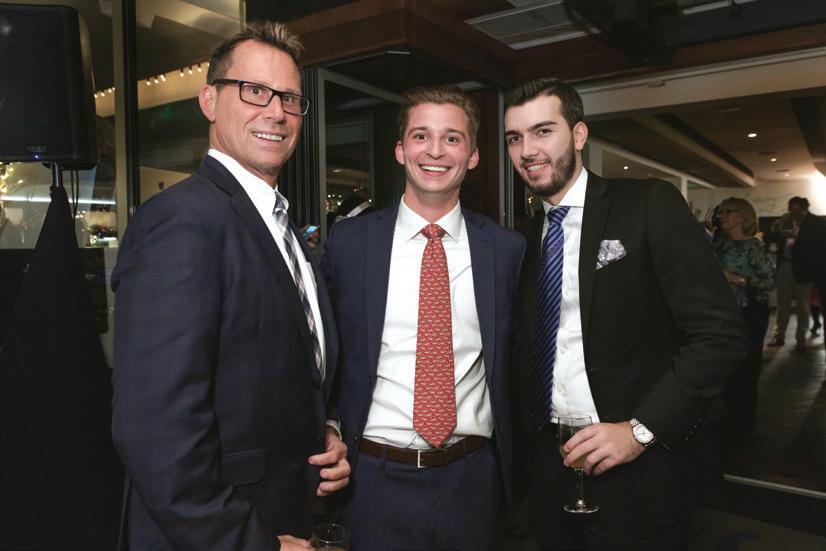







Carriage
Scap
California Closets
Cory Lloyd & Co.

Robert A. Cardello Architects

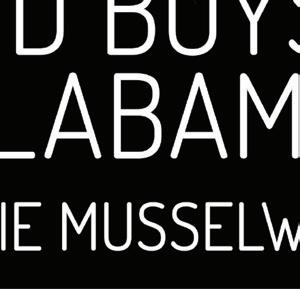

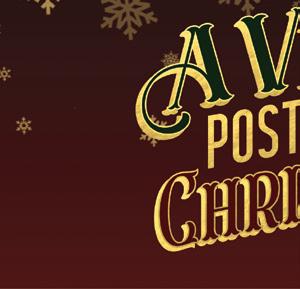




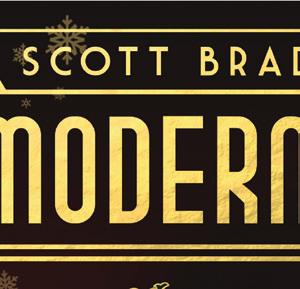















Cummings
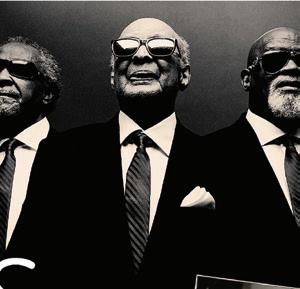
Quick
Winvian
Breast

Uh oh, it’s November, the threshold of the holidays, time to make a gift list and take inventory. For me that means heading for my Surprise Closet, which is filled with things ungiven—yet. I squirrel them away all year long. Some have been in there forever, awaiting the right recipient.
It’s the only place in our house that’s locked. For good reason, nobody is allowed in there but me. When daughter Audrey was about four and meant to be napping, I found her playing with a baby doll she’d helped herself to from that closet. It was meant for her birthday. So I put them both into the car, drove over to the Goodwill box behind the Cos Cob Food Mart and we popped it in—for some little girl somewhere who played by the rules.
As luck would have it, the Goodwill truck pulled in that very moment, and I asked the driver if he happened to have a little girl at home. He did. I told him there was a brand-new doll in there right in top— complete with box—and we’d like her to have it.
Lesson learned. Closet locked.
So what’s in there now? Before I run out to do some serious Christmas shopping, best I take a look. Among other things, four pocket drones from Hammacher-Schlemmer for the older grandsons. A small Windsor chair from the Winterthur Museum, perfect for a baby girl present, especially with a pintsized Raggedy Ann doll to sit in it. And a 104-piece construction set for making plastic drinking straws, so big brother doesn’t feel left out.
There’s a Wizard of Oz pop-up book, two Klutz how-to books on making paper flowers and foam gliders, bags full of prizes for our annual family fishing contest and three pillows I needlepointed for wedding presents. Oh, and a box of Mickey Mouse golf balls from the time Jack and I went (without children) to Disney
World, visited Epcot every morning and played golf every afternoon. Did you know they have sand traps in the shape of Mickey Mouse heads?
From other great trips, there’s a Pinocchio marionette from Prague, a miniature tea set from Vienna embossed with Mozart’s portrait and a souvenir spoon depicting train cars from Rodo Rails in Africa. Closer to home, from the Basin Harbor golf course on Lake Champlain is a bunch of seagull feathers I plan to give the little boy across the street for his collection.
Audrey has always been into pigs, so awaiting her is a pink pig puppet that oinks. In the political realm are Trump playing cards, a Hillary nutcracker and a tiny tin of Ruth Bader Ginsburg’s “Judgmints” I’ll slip into a birthday card for a League of Women Voter friend.

There’s a stack of Greenwich magazine baseball caps to give to our fans, and The New York Times from our grandchildren’s birth dates to present on an occasion like a rehearsal dinner.
Sometimes I surprise myself with what I find in my Surprise Closet—like a little framed memento from the Flask & Bottle Club, which Jack and some of his fun-loving friends founded during their college years. It reads: “There’s the wonderful love of a beautiful maid/ And the love of a staunch true man/ And the love of a baby that’s unafraid. / All have existed since time began. / But the most wonderful love, the love of all loves/ Even greater than the love for Mother,/ Is the infinite, tenderest, passionate love/ Of one dead drunk for another.”
What to do with it? A hostess present for over somebody’s bar? Who knows, but meanwhile it gives me a good laugh, which is never a bad thing.
Now it’s about all this other stuff.
ELEGANT, SINGLE-LEVEL CONDOMINIUM RESIDENCES OVERLOOKING THE FIVE MILE RIVER IN ROWAYTON, CONNECTICUT.


Designed by award-winning architect, Bruce Beinfield, and built to the absolute highest standards.



